|
Harv
|
 |
« Reply #300 on: November 27, 2015, 03:33:10 PM » |
0
|
Ladies and gents, Some more info from Gary’s overhaul. Similarly to Eldred’s superchargers, Mike’s superchargers used a cast manifold between the carburettor and the supercharger. The photos below show one of Mike’s manifolds. The manifold will fit the 350 and 400 Normans (and probably the 300), it appears to be too long to fit the shorter Normans (150, 200 and 250) Whilst the manifold below is a genuine Norman manifold, it has been butchered a bit: a) by welding on an inlet flange to suit an 1¾” SU carburettor (2 1/8” centres, square pitch), b) by welding on a great big bit of aluminium bar to act as a carburettor spring return (with four holes to allow you to adjust spring tension), and c) By welding up the tappings in either end of the manifold. 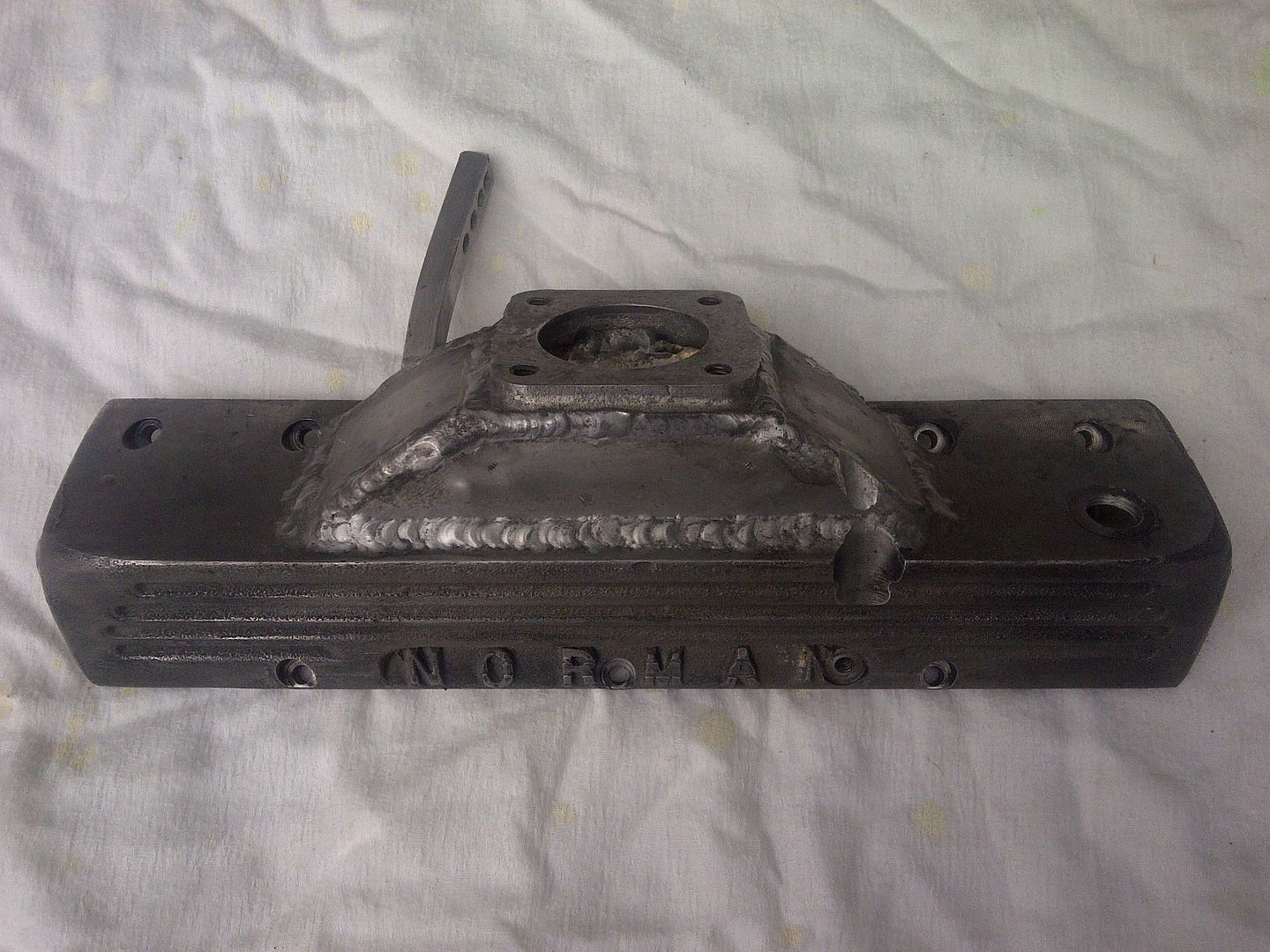 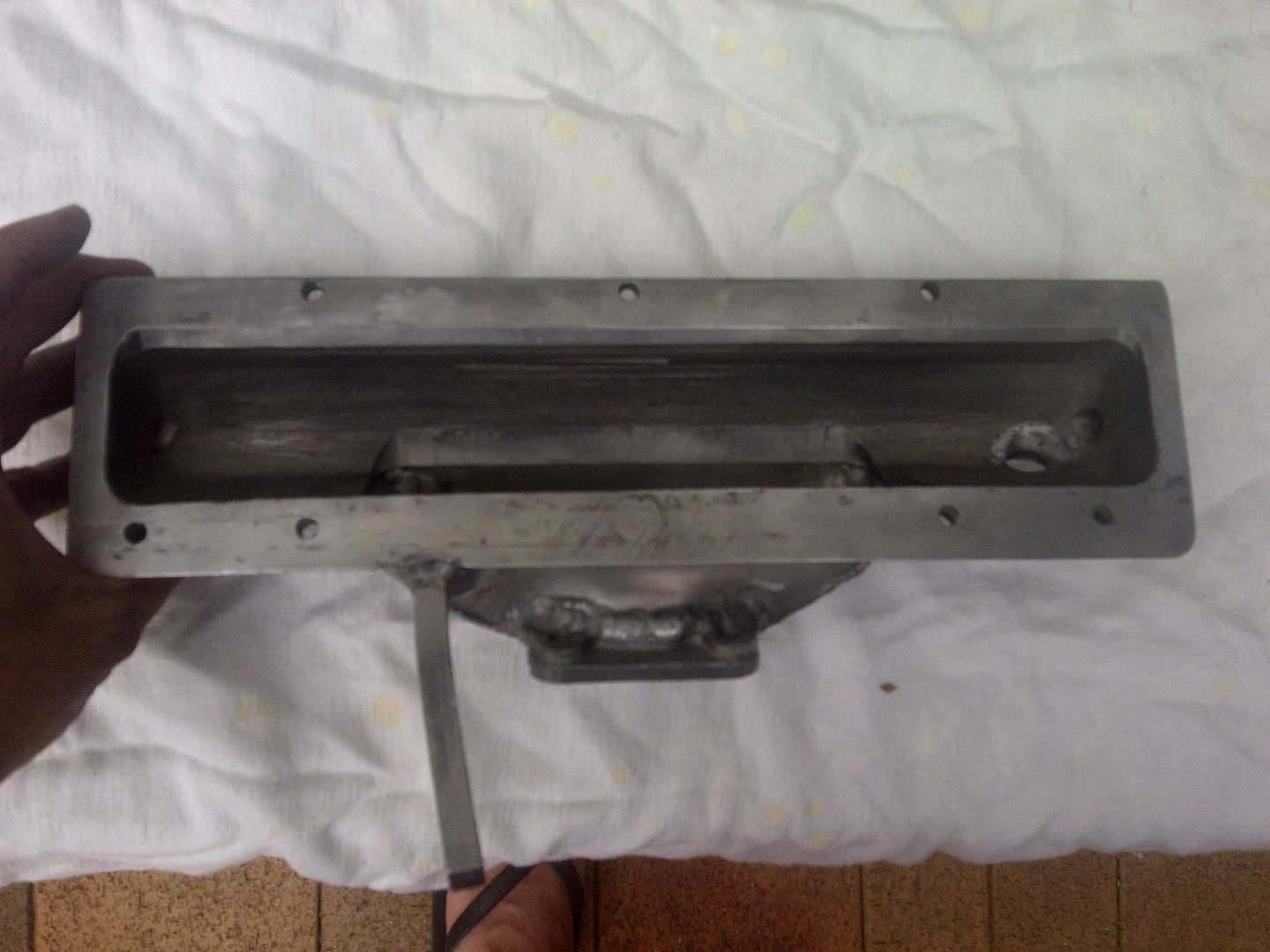 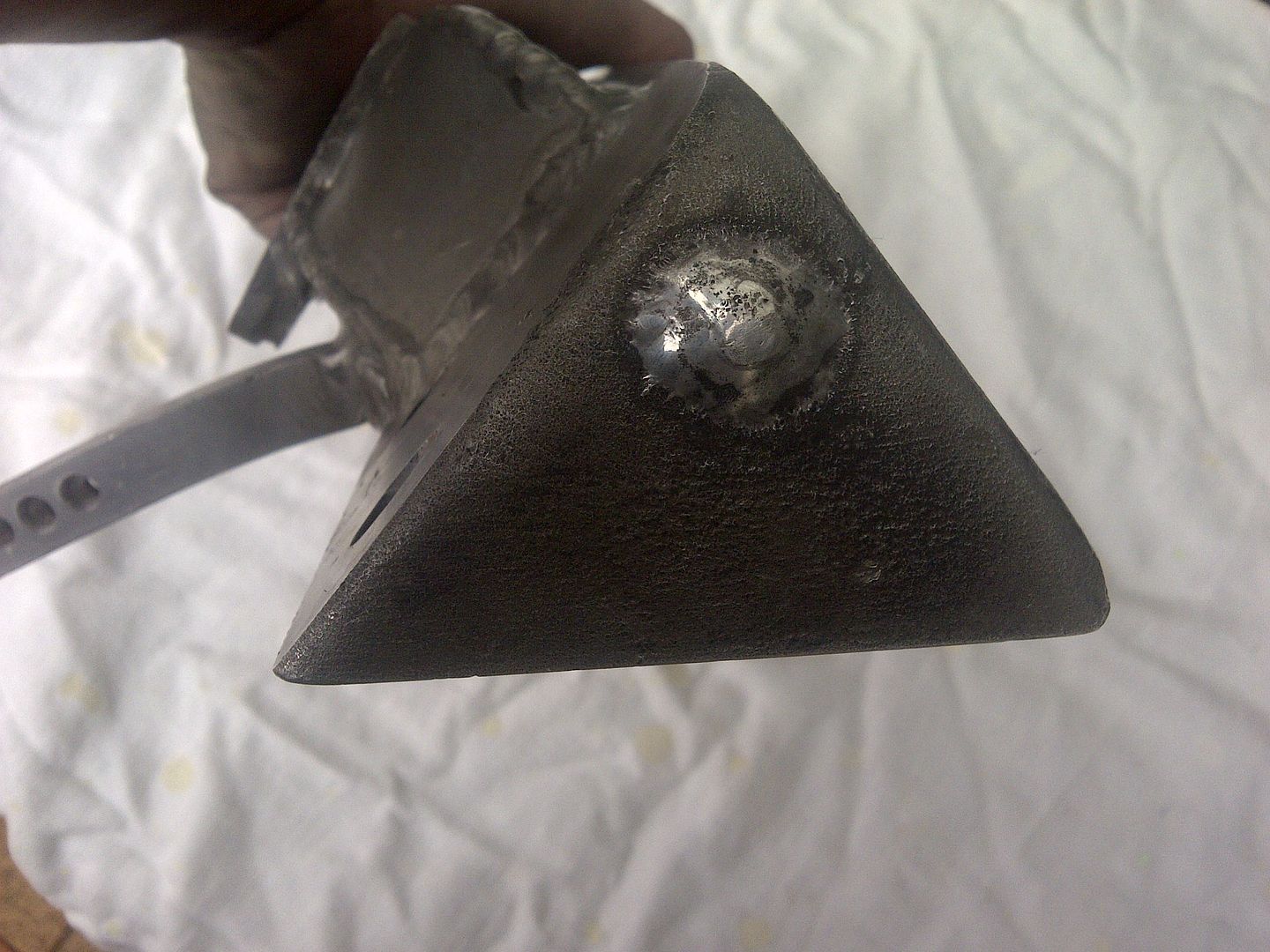 Eldred’s manifolds bolt directly to the supercharger using studs. As I found out the hard way, the stud holes in Eldred’s superchargers are not precisely spaced. Mike’s Normans however do not bolt the manifolds directly to the supercharger. The extruded aluminium supercharger casings are made with channels either side of the inlet and discharge ports. The channels are used to locate steel strips, with tapped holes drilled into the strips. Studs, or short set screws, are used to mount the manifolds to the steel strips. The manifolds are this not positively bolted to the superchager – they rely on the clamping force of the steel strips against the channel to stop the manifold moving. The photo below shows the channels and a steel strip being fitted in place. 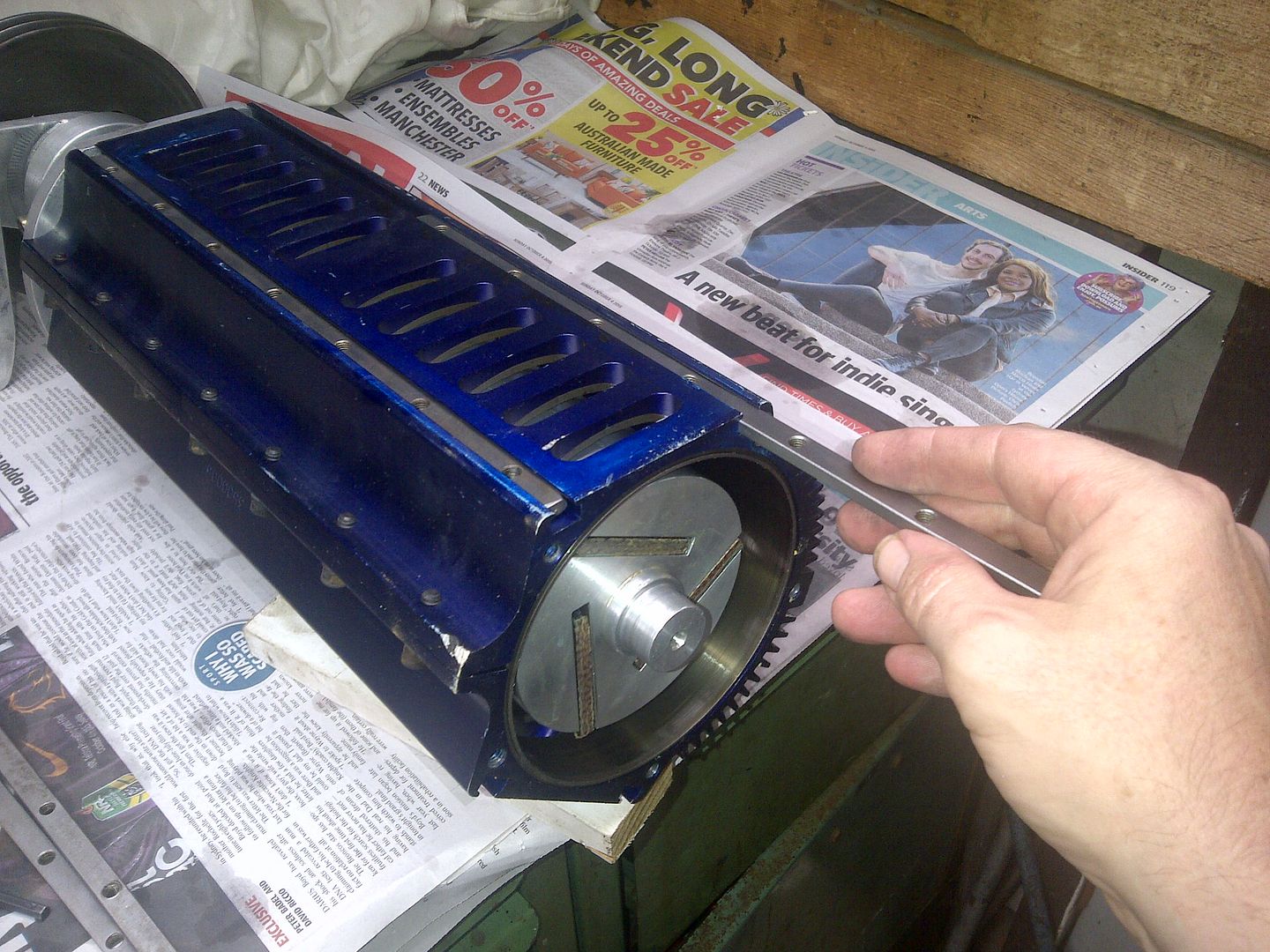 |
|
|
|
|
 Logged
Logged
|
|
|
|
|
Harv
|
 |
« Reply #301 on: November 27, 2015, 03:33:46 PM » |
0
|
Pictured below is a home-made relief valve (from Gary’s 350 Norman), similar to the ones made by Weiand (part number 7155), The Blower Shop (part number 2589) and AussieSpeed (universal backfire valve). 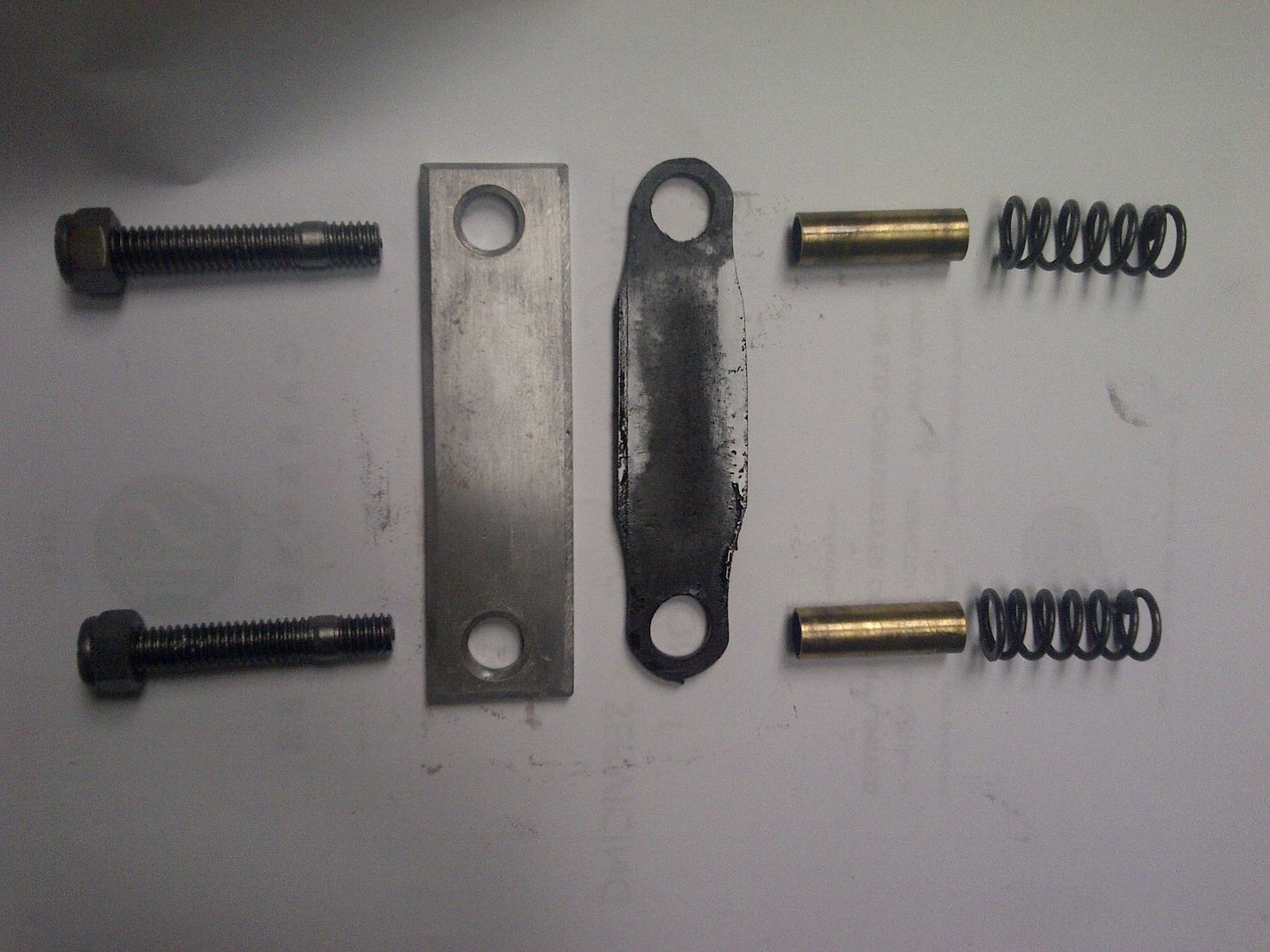 This is a rubber-sealed rectangular plate held in place by two springs. Two studs screw into the aluminium adaptor, with some 5/16-14 UNC nyloc nuts used to compress the springs. The two brass sleeves shown in the photograph above are used to set how far the nuts can tighten – shorter sleeves let the nuts tighten more, which compresses the springs more, and gives a higher relief valve pressure. I really like the use of these brass spacers – they mean that every time the valve is reassembled, you know you are setting the correct relief valve pressure (provided the springs have not lost tension) and do not need to pop-test. The springs have a tension of 88lb/inch, and can compress from a free length of 1.169” down to 0.739” at coil bind (0.43” of compression). This means that between the two springs the clamping force is 0-76lb. The rectangular relief valve hole in the manifold has a cross section of some 0.92inch2. This means that the relief valve (with the current springs) can be set from 0-82psi. The current brass spacers give a spring compression of 0.338”, a clamping force of 59lb, and a set pressure of 64psi. Note that all the above is by calculation only, and would need to be verified by a pressure (pop) test before the manifold was used in anger. I’m not a big fan of nyloc nuts on relief valves, (which is why I used safety wire on Gary’s Type 65 relief valve), though it will work as long as the nyloc nuts are new. Not a good idea to reuse the nuts. Very, very rough calculations show that 4 inch2 of relief valve area is appropriate for the red motor type Normans (200ci/rev) operating around 4500rpm. The smaller Normans (80ci/rev) would still need around 2 inch2, though are safer at 4 inch2. This means that the relief valve shown above (0.92inch2) is a little small, as are the Weiand (0.8inch2) and The Blower Shop (0.44inch2) offerings. Relief valves of this size should either be doubled up (one at either end of the manifold) or used in conjunction with a burst plate. |
|
|
|
|
 Logged
Logged
|
|
|
|
|
Harv
|
 |
« Reply #302 on: November 27, 2015, 03:34:20 PM » |
0
|
One other item of note from Gary’s 350 Norman overhaul is that the rotor has a keeper fitted at the non-drive end of the rotor driveshaft. This consists of a set screw and washer, which fit into the tapped end of the rotor shaft. 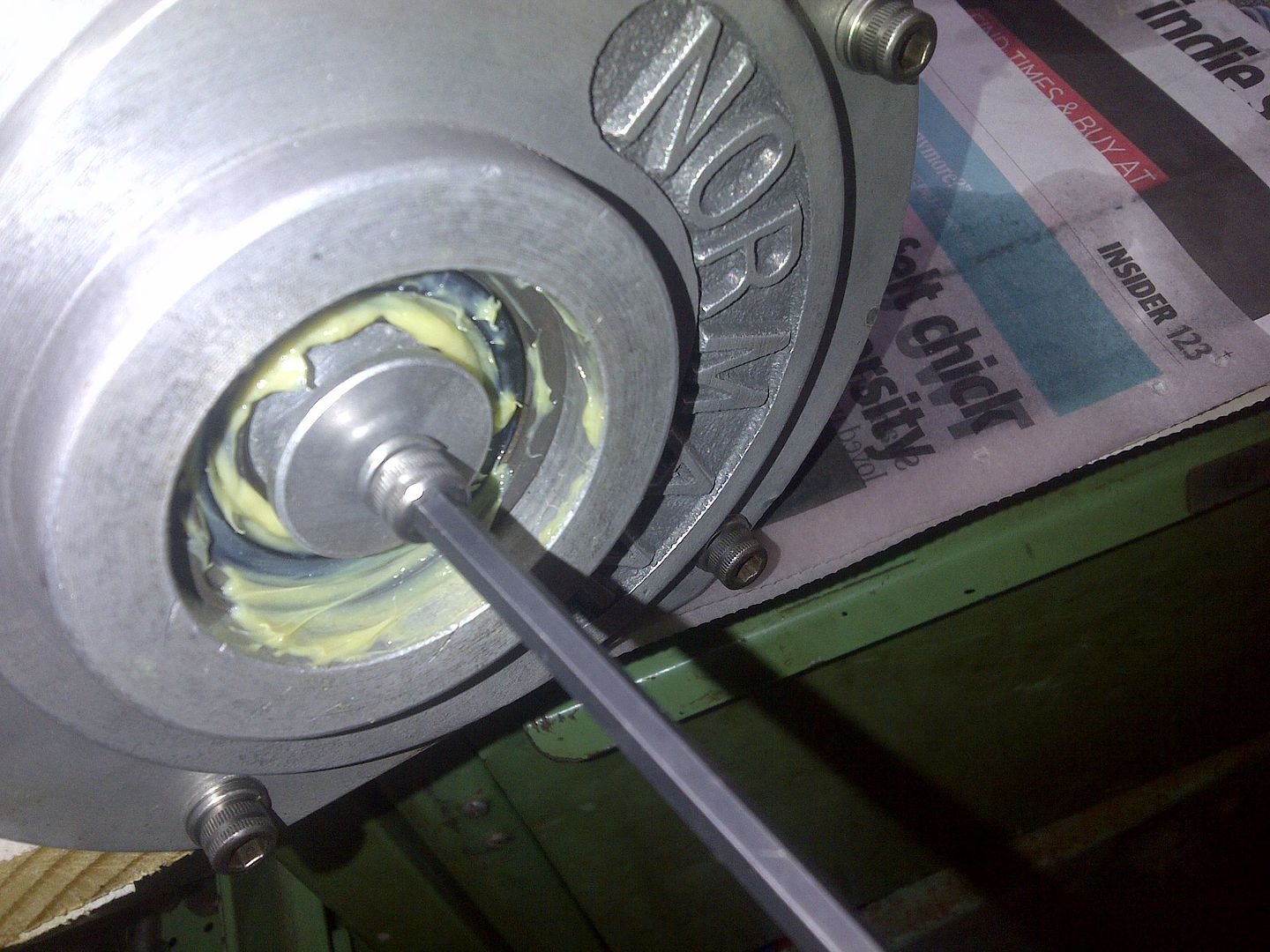 The purpose of the retainer depends heavily on what size washer is used. One option is where the washer is sized such that it is small enough to pass through the bearing outer race. This allows the rotor to move as much as it wants relative to the casing, and only holds the bearing inner race onto the shaft (bear in mind that Norman non-drive end bearings are two piece, allowing the inner and outer races to slip over one another). Realistically, the bearing inner race is a press fit onto the shaft, and unlikely to move (i.e. this option is not very useful) The better option is where the washer diameter is large enough to bear against the bearing outer race. With the rotor cold, the washer almost touches the bearing inner race. As the supercharger heats up, the rotor grows and the inner race moves towards the end of the casing. The distance between the washer and outer bearing increases. As the rotor cools again (when the vehicle is stopper), the washer approaches the outer race. If the rotor is given a shunt towards the drive end, the washer bears against the outer race, preventing the rotor rubbing on the drive-end end plate. A further set of three keepers are fitted to the drive-end end plate. These small tabs retain the drive-end seal into the end plate, as per the image below. This prevents high boost pressure from driving out the seal. The drive end keepers appear to have been fitted to all of Mike’s Norman supercharger. 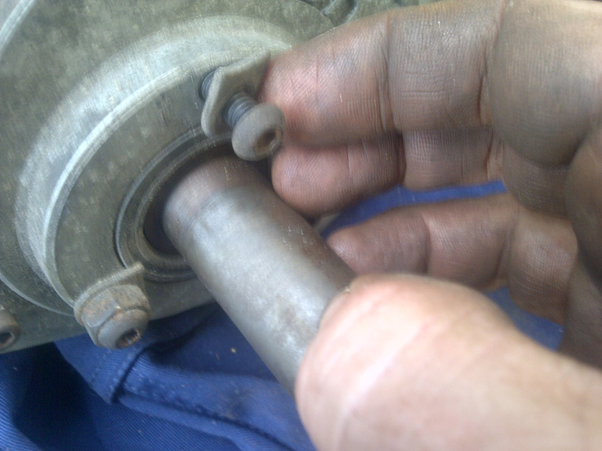 I have also seen similar keepers fitted to some Norman non-drive end end plates in order to prevent the welsh plug being blown out under boost. 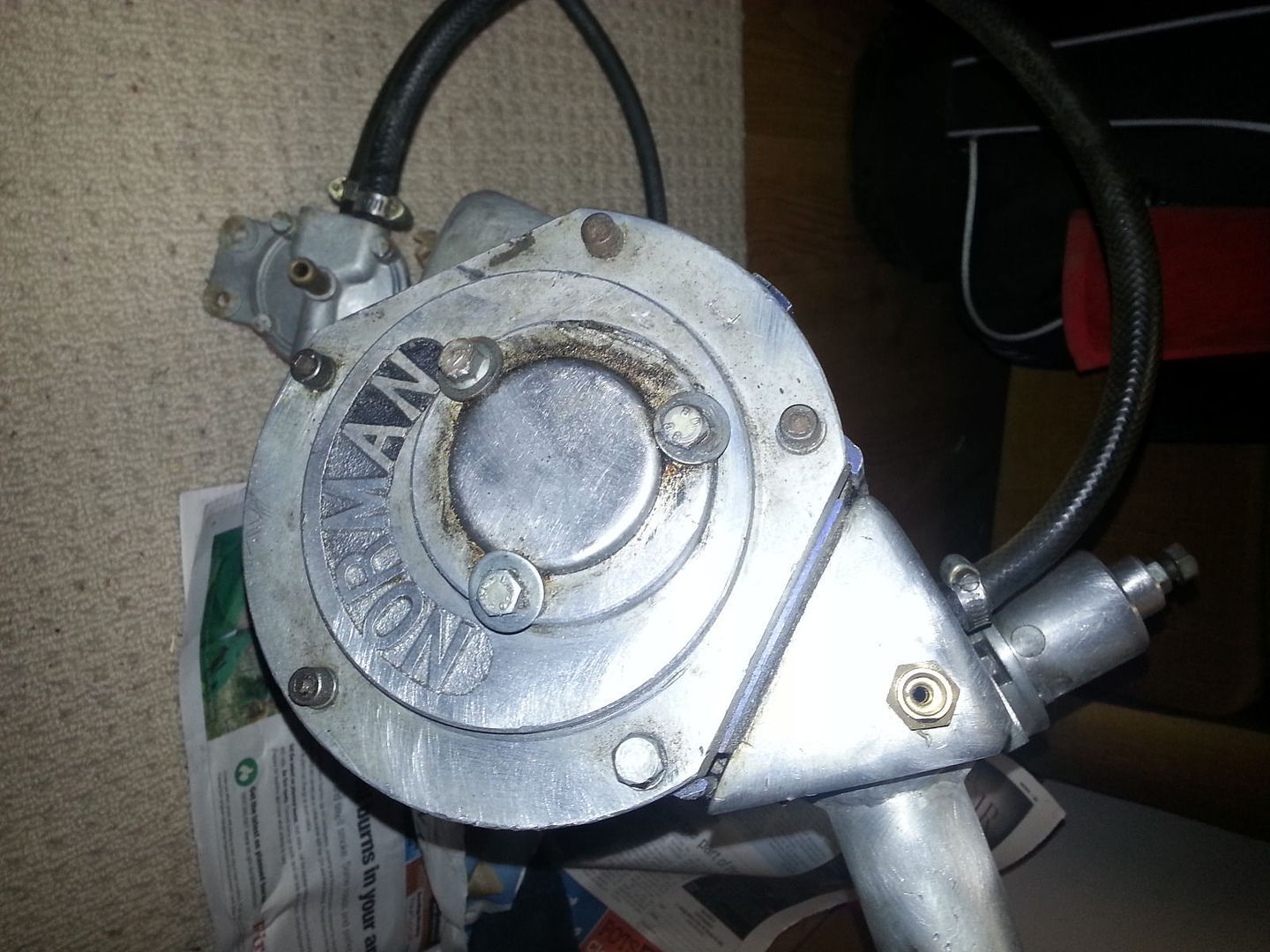 Cheers, Harv (deputy apprentice Norman supercharger fiddler). |
|
|
|
|
 Logged
Logged
|
|
|
|
|
Harv
|
 |
« Reply #303 on: November 30, 2015, 10:36:10 AM » |
0
|
Ladies and gents,
As I’ve been working through the Norman supercharger history, I keep running across links to Australian motorsport. I’ve run across another such link, and am interested in hunting it down. It involves an air cooled Type 65 Norman that changed hands a few years ago. The Norman was running triple 1.25” SUs when sold. Heres some of the story:
Kevin Wood owned an Elfin 600 with a 1st series Toyota Celica engine and Norman supercharger. The blue vehicle was purchased for $2,000. Kevin did not run the Elfin with a body, instead using large wings front and rear. The Norman had been sourced from Barry Bray's Datsun 2000 powered A30 sports sedan, whilst the Elfin had once belonged to Barry Kirk. Kevin sold the Elfin to Roger Seward for $8500, who fitted a Lotus twin-cam and got a historic log book before onselling the Elfin for some $30,000. Peter Smeets bought the motor and Norman supercharger, and gave the Celica motor to Jim Doig for a bottle of red wine. The supercharger was sold to a person who was putting it on a FB Holden, along with a copy of Eldred’s Supercharge! book. This is the person I am hunting down. The FB owner was a young gentleman who worked at Bunnings Marion, South Australia.
Interested to hear from anyone who knows of the mysterious Marion owner.
Cheers,
Harv
|
|
|
|
|
 Logged
Logged
|
|
|
|
|
Harv
|
 |
« Reply #304 on: November 30, 2015, 04:21:40 PM » |
0
|
The photos below show Ian Richards self-built Viper Peugeot. The vehicle was built around 1967/1968. 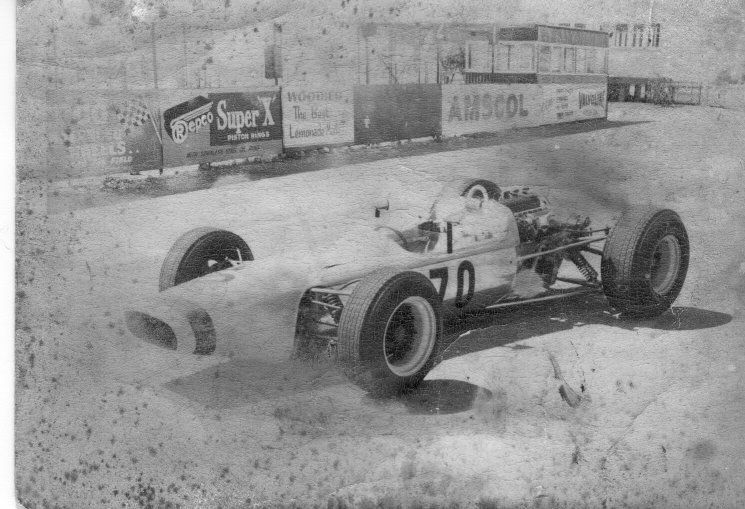 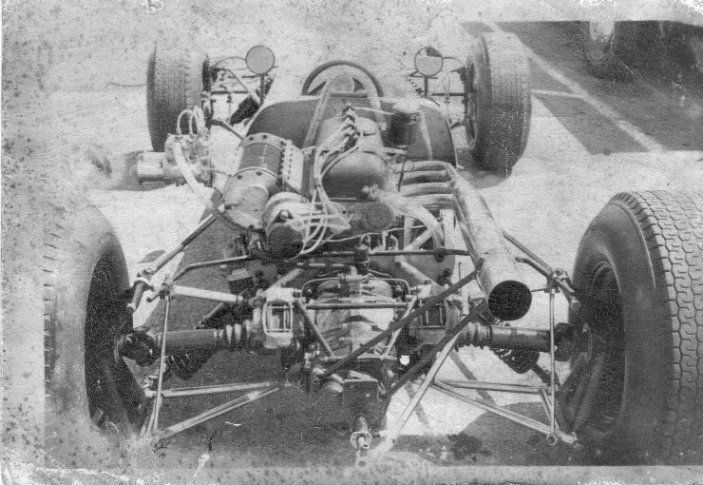 Ian used to transport the Viper to various racing circuits on the tray of a Peugeot 403 utility, with parts of the Viper protruding into the utility cabin through a custom-made hole. Ian currently runs his own team of F3 cars, with a more refined transporter  . In between times Ian built and raced the Richards F2 cars winning the 1983 Australian F2 title. Ian was an apprentice fitter and turner at Southcott’s when he built the car in his Mum’s shed. A fellow pattern making apprentice made the patterns for the rear uprights from a photo in a book complete with “Viper” cast into them. A chassis jig from the WRE (Weapons Research Establishment) car club was used to position the frame, which was then arc welded by a guy that worked at Holden’s using “very skinny electrodes” (race car chassis in this era were typically brazed together using nickel bronze). Ian cut the close ratio gears for the Volkswagen split case gear box himself, using ratios suggested by Garry Cooper (of Elfin fame). More assistance from Elfin came in the form of the nose cone, which was made by an Elfin panelman as an afterhours job at Ian’s mum’s shed. The car raced without wings initially, then with suspension mounted wings (which were banned worldwide after failures in F1 in Europe) then with chassis mounted wings. The Viper ran a Peugot 403 motor. However, the 403 motor tended to crack the block at the cylinder liners. The block was replaced with a 203 block, which was bored out to suit. Ian worked with Alec Rowe, with Alec being no stranger to Norman supercharged Peugeot motors. The Pug motor was fitted with an air-cooled iron cased Norman (very likely to have been a Type 65). The casing was lightened by machining some of the fins back. The heavy steel rotor was replaced with a lightweight aluminum unit, with steel driveshafts pressed in. Boost was around 8-10psi. The Norman had a tendency to break the lightweight rotors, with replacement units having the vane root web thickness increased. The Viper ran a single DCOE Weber carburettor on alcohol, with a supplementary fuel injection to provide enrichment as not enough methanol would flow through the Weber. I believe the photos below show the car in later revisions, with some changes in induction evident. The Norman however remained on the vehicle throughout it’s life. The vehicle was eventually broken up, with the Norman-blown pug motor being fitted by Ian into a speedcar owned by Dennis Freeman. The back-end of the vehicle would find a home in a Corolla Sports Sedan in Port Pirie.  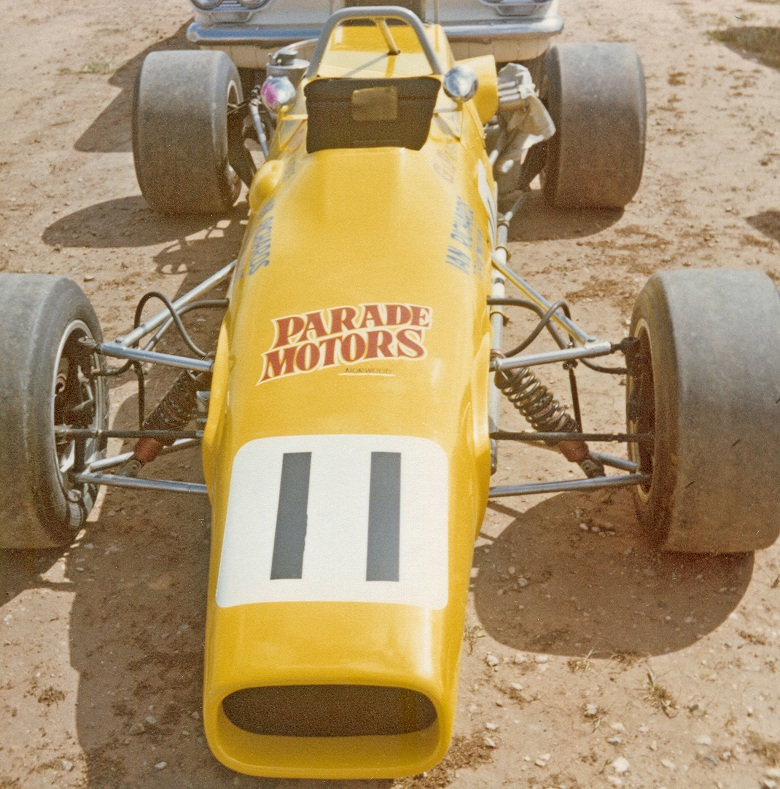 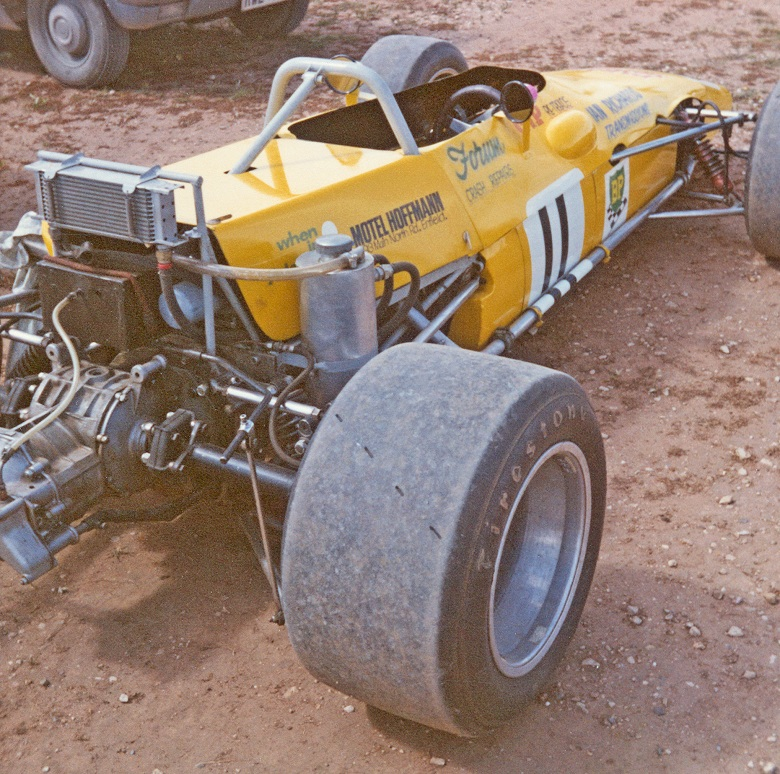 Cheers, Harv |
|
|
|
|
 Logged
Logged
|
|
|
|
|
Harv
|
 |
« Reply #305 on: December 08, 2015, 12:39:45 PM » |
0
|
Following on from my Eldred Norman anecdote, I got to thinking about the period in Australia’s automotive history. The 1950’s and 1960’s were a period where we still relied heavily on local product – the market flooding of readily available imported go-fast parts for the small block Chev had yet to occur. This need for local equipment spurred on some very cool Australian engineering, including Eldred’s work. In the local forced induction field, there were numerous people bolting on (or making kits for) imported superchargers. This is a phenomena we see today with both Harrop (who kit out the Eaton TVS machines), the Castlemaine Rod Shop (who kit out the Aisin SC14 machine), and Yella Terra (who kit out the Eaton M90). Sprintex are perhaps the only Australian company who manufacture their own (twin screw) machines.
What is interesting (and also rather cool) is that Eldred was not the only Australian who was manufacturing superchargers (and not just kits) in the 1950’s and 1960’s period. One of Eldred’s contemporaries, competitors, and fellow South Australian was John G. Wray. The anecdote below tries to paint a picture of the Wray supercharger history. Just like my Eldred Norman anecdote, a word of warning regarding the information below. Some of the people who witnessed the events below have sadly passed away, including John Wray. It has also been half a century since the Wray supercharger was conceived. This anecdote has been written drawing together information from a broad variety of sources, many of whom are trying to remember events of fifty years ago. There may be inconsistencies with the information, or outright errors. Caveat emptor. I also owe a debt of thanks to a great number of people who helped pulled together the pieces of the “patchwork quilt” that became my Wray anecdote.
1. J.G. Wray
John Graham Wray was born in 1930, at an unknown location, in Australia. John married, and he and his wife Margaret did not have children. John spent some of his early years in England with his wife on a working holiday. His interest there was in automotive engineering and sporting cars. On return to Australia John was working as a Castrol sales representative, with Margaret working as a nurse. Over time John accumulated quite a few engineering tools and machines. He eventually started a small engineering shop (J.G. Wray General & Maintenance Engineering) at Newman Lane Glenelg, South Australia. The shop catered for general and maintenance engineering with John and staff being involved with the following activities:
• Small production runs of components for machinery,
• Design, manufacture and maintenance of machinery for the testing and manufacturing of automotive components,
• Design, manufacture and maintenance of machinery for the textile industry,
• Manufacture of marine components,
• Manufacture and maintenance of mining equipment, and
• Jobbing and ‘one off’ work.
Wray Engineering raised patents for example on a “burr beater” agricultural implement.
John owned a white hardtop MGA 1558cc twin-cam that he either brought back from or imported from the UK. He later sold the MGA to purchase an Alpha Romeo GTA. John’s main interest at that time was with yachts, bringing with that interest numerous customers to the company with the manufacture and development of marine parts and marine maintenance. John constructed a 30ft double-ended fibreglass ocean going yacht in one of the workshop bays. He used the yacht for many years until health issues forced him to sell it. His other interest in later years was exploring outback Australia in his 4WD. John passed away about eight years ago in Adelaide. The following article is drawn from the (Adelaide) Advertiser of the 14th of October 1954:
|
|
|
|
|
 Logged
Logged
|
|
|
|
|
Harv
|
 |
« Reply #306 on: December 08, 2015, 12:40:35 PM » |
0
|
Vintage Racing Car Has History Historic Racer A vintage racing car, now being rebuilt in South Australia, has one of the most colourful histories of any vehicle in this State, and because of its age an even more colourful one than the ex-Prince Birabongse, MG K3, owned by Andy Brown. The car is a 1923 2-litre Miller, owned by Gordon Haviland, and at present being rebuilt by John Wray and Len Poultridge. Believed to be the first Miller to leave America, the car was taken to Europe in 1923 with two other Millers to compete in under 2-litre formula races. Count Louis Zborowski took delivery of the first car and entered it in the Spanish Grand Prix, run at Sitges-Terramar, in which he finished second. The other Millers also ran against Zborowski in the Grand Prix de l’Europe, at Monza, one of them, driven by Murphy, scoring third position. Count Zborowski kept his car when the other two returned to the US, and raced it in late 1923 and early 1924 before competing in the 1924 French Grand Prix. Well known author and writer in 'Autocar,' S. C. H. Davis was Zborowski's mechanic on this occasion. The introduction of the supercharger on other vehicles gave the Miller a considerable disadvantage in this event, but when 'blowers' were fitted, an American driver, Harry Hartz, covered 50 miles at 135 m.p.h in 1925. The Miller did not finish in the French Grand Prix, and Count Zborowski was killed at Monza shortly afterwards when his Mercedes skidded into a tree during the running of the Italian Grand Prix. All Zborowski's cars were then sold. The car was bought by Dan Higgen and raced at Southport Sands, in England in 1925. The Miller covered the flying kilometre in 25 seconds, and finished fourth. It raced in several events at Brooklands and in other meetings during 1925 and 1926. The car came to Australia a year or so later. It has had several owners in this country and competed in numerous hill climb and other events. The body has been lowered, but it still retains its original Miller engine. Picture shows John Wray working on the car this week.  A South Australian with a passion for old race vehicles who goes on to build his own superchargers? Sounds like another gentleman we have met before . As an aside, Count Zborowski built and raced the original Chitty Chitty Bang Bang… with a 23-litre Maybach aero engine (!). The Miller 122 shown in the photograph above is centrifugally supercharged. Wray superchargers were manufactured at the Glenelg factory up until about 1967. The company moved to larger premises at nearby 46 Byre Avenue, Somerton Park in 1970 (now home to Tintworks window tinting), where production continued until about 1983. The image below, lifted from the internet, shows the Somerton Park facility in 2009, which is very similar to how it looked in the early 1980s. 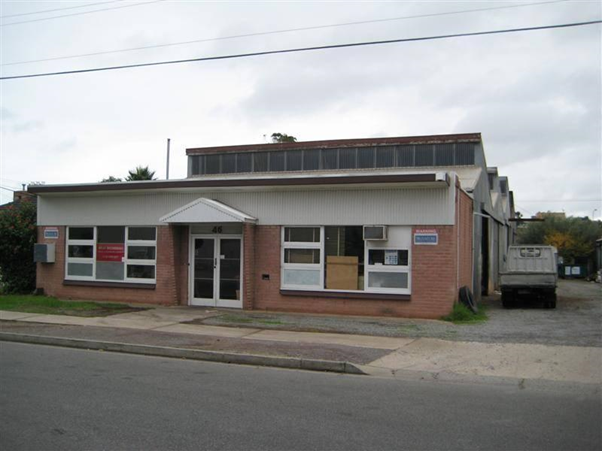 John Wray’s direct involvement in the manufacture of the superchargers continued until about 1974. Wray superchargers manufactured after that time were still made at Wray Engineering, but manufactured by staff after hours and on weekends, with little to no advice from John. Batches of superchargers would be made, and sold to speed shops. It is estimated that around fifty superchargers were built in this fashion. Whilst quite a few people were employed at the Wray works, a few were heavily involved in the supercharger side of the business. James (Robbie) Robinson started at the Glenelg workshop and moved to Somerton Park. He was a leading hand until he left about the mid 1970’s. Greg Pill started as an apprentice in 1970 and worked there until 1985, having been a leading hand for about nine years. Robert (Bob) Cronin worked as a machinist from about 1975 until 1983. We will hear more about Robbie, Greg and Bob (and their vehicles) later in this anecdote. |
|
|
|
|
 Logged
Logged
|
|
|
|
|
Harv
|
 |
« Reply #307 on: December 08, 2015, 12:41:12 PM » |
0
|
2. Wray Supercharger Models Like the Norman and Judson superchargers, the Wray supercharger was a sliding vane unit operating at relatively low pressure (~5psi boost). Like the Judson, and unlike some Normans, all Wray supercharger casings are 100% air-cooled. Wray offered two sizes, the smaller having a displacement of 60ci/rev (960cc) and the larger a displacement of 96ci/rev (1530cc). Note that these capacities of swept volume are calculated using the “modern” method of measuring them. In the example drawing below this means work out the volume shown in red, and multiplying it by six (yes, yes, I know, the Wray has four vanes… . it’s just an example ).  An alternate method was used in this period by Eldred Norman (and is noted in his book Supercharge!). Referring to the drawing above, Eldred’s method determines the volume shown in orange. Eldred’s method is neither more right nor more wrong than the “modern” method… just different. It also gives different results – a lot smaller number than the modern method. As an example, when we measure a Type 65 Norman supercharger using the modern method, we get 118ci/rev. However, when we measure the Type 65 using Eldred’s method, we get 67ci/rev (near enough to 65ci, and hence the name). The modern method is heavily dependent on port timing, whereas Eldred’s method is independent of port location. Using Eldred’s method, the table below compares the Wray superchargers to their contemporaries:  Both Wray supercharger sizes were available with the inlet and outlet port 180º apart (the “T” model) or 270º apart (the “L” model), giving a total of four variants – L60, T60, L96 and T96. Whilst the literature shown later in this anecdote indicates a T60 being made, it is not certain that this ever eventuated. The L superchargers allow a more compact design, allowing installation between the engine block and the firewall of BMC vehicles. The supercharger was bolted directly to the cylinder head, the inlet manifold ran across the bottom of the casing, extending past the end plate. A downdraft carburettor was located next to the end plate between the engine block and the firewall. The larger supercharger casings were produced in two models: the first with the same design porting (90º) as the smaller superchargers, and the second with a cross-flow (180º) porting. The variations were achieved by utilizing an internal chamber (in the casting) between the liner and the outlet port. The liner porting was the same for both models. The small L60 and T60 superchargers were originally marketed and sold in kit form for the various BMC ‘A’ and ‘B’ engines (including Minis), Ford Cortina 1.2-1.6L four cylinder engines and Renault R8/R10 956cc-1289cc models. The larger L96 and T96 superchargers targeted the 132.5-138ci Holden grey engine. Over the years the superchargers were sold and put to use on numerous applications ranging from 750cc motorcycle engines through to the 202ci Holden red engine. The image shown below is taken from the 1968 Aunger Speed Equipment Retail and Mail Order Catalogue, and shows some of the Wray kits offered. It is a little cheeky… the image to the bottom right is a Judson supercharger kit and Holley carburettor to suit an Austin Healey Sprite.  The image below shows both the larger and smaller Wray superchargers (photo: Fred Radman). Note the absence of the T60 supercharger in the image… it may never have been made by J.G. Wray. |
|
|
|
|
 Logged
Logged
|
|
|
|
|
Harv
|
 |
« Reply #308 on: December 08, 2015, 12:42:08 PM » |
0
|
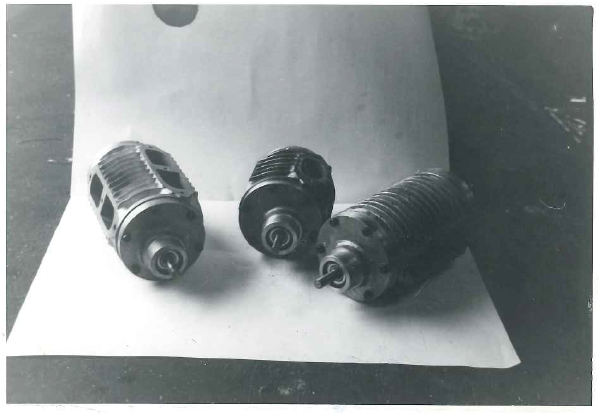 Some Wray superchargers were stamped with serial numbers, including the first one (Mike McInerney, who test-piloted it, can remember John Wray stamping the machine). However, the process was not systematic – none of the those manufactured during Greg’s time at Wray Engineering were numbered, nor any that returned for maintenance. The newspaper clipping below is from Adelaide’s The Advertiser of Tuesday, February 7th 1967: 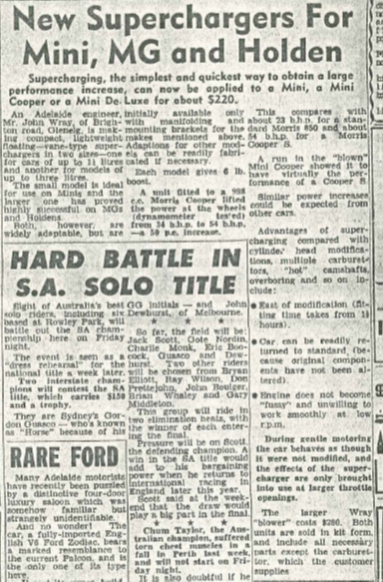 Interestingly, Andrew Mustard was a sales agent for Wray. From my earlier anecdote, Mustard was involved in the Bluebird land speed trials, and owned the Norman-blown Elfin which still holds Australian land speed records. The Elfin, and those records, get a mention in the sales literature below, which I have drawn from Fred’s collection: 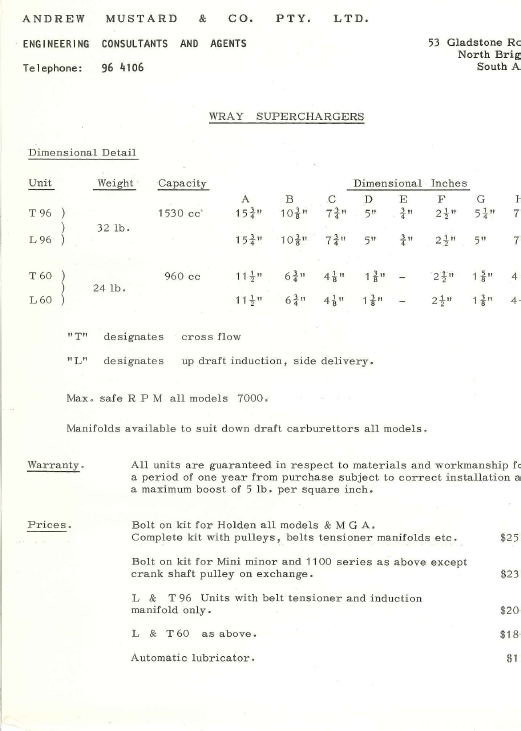 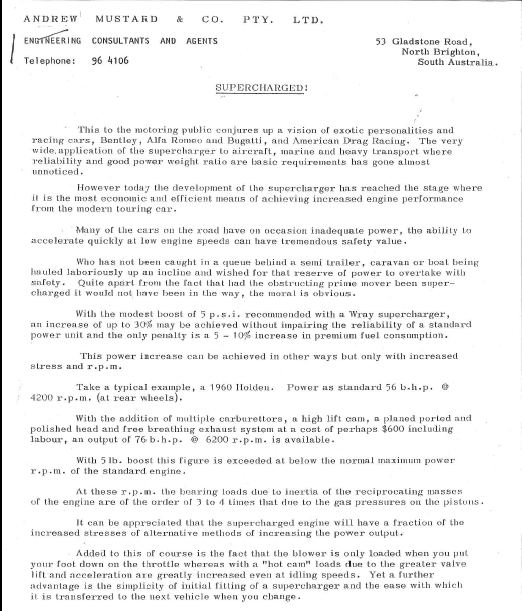 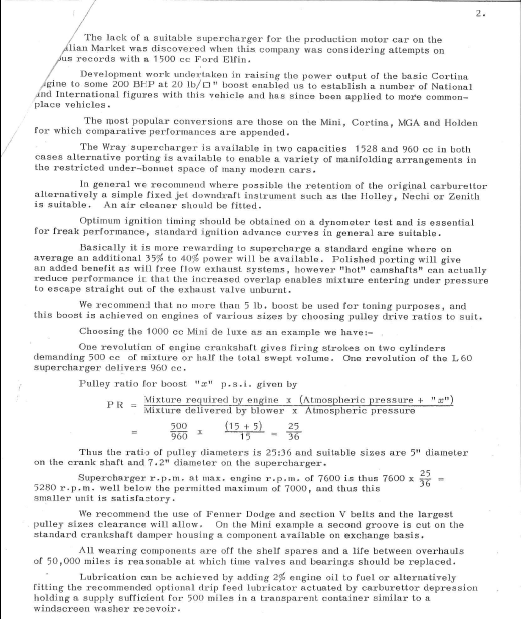 It is interesting that Mustard describes phenomena that still apply today – the lower engine stress associated with supercharging, and the effect of valve overlap on boost. Most of the Wray superchargers were installed by the purchasers, while a few custom installations were done at the factory. 3. Wray Supercharger Construction John Wray designed and made all of the drawings, timber patterns, tooling and jigs for the Wray superchargers. The pattern for the L96 is shown below (photo: Fred Radman). 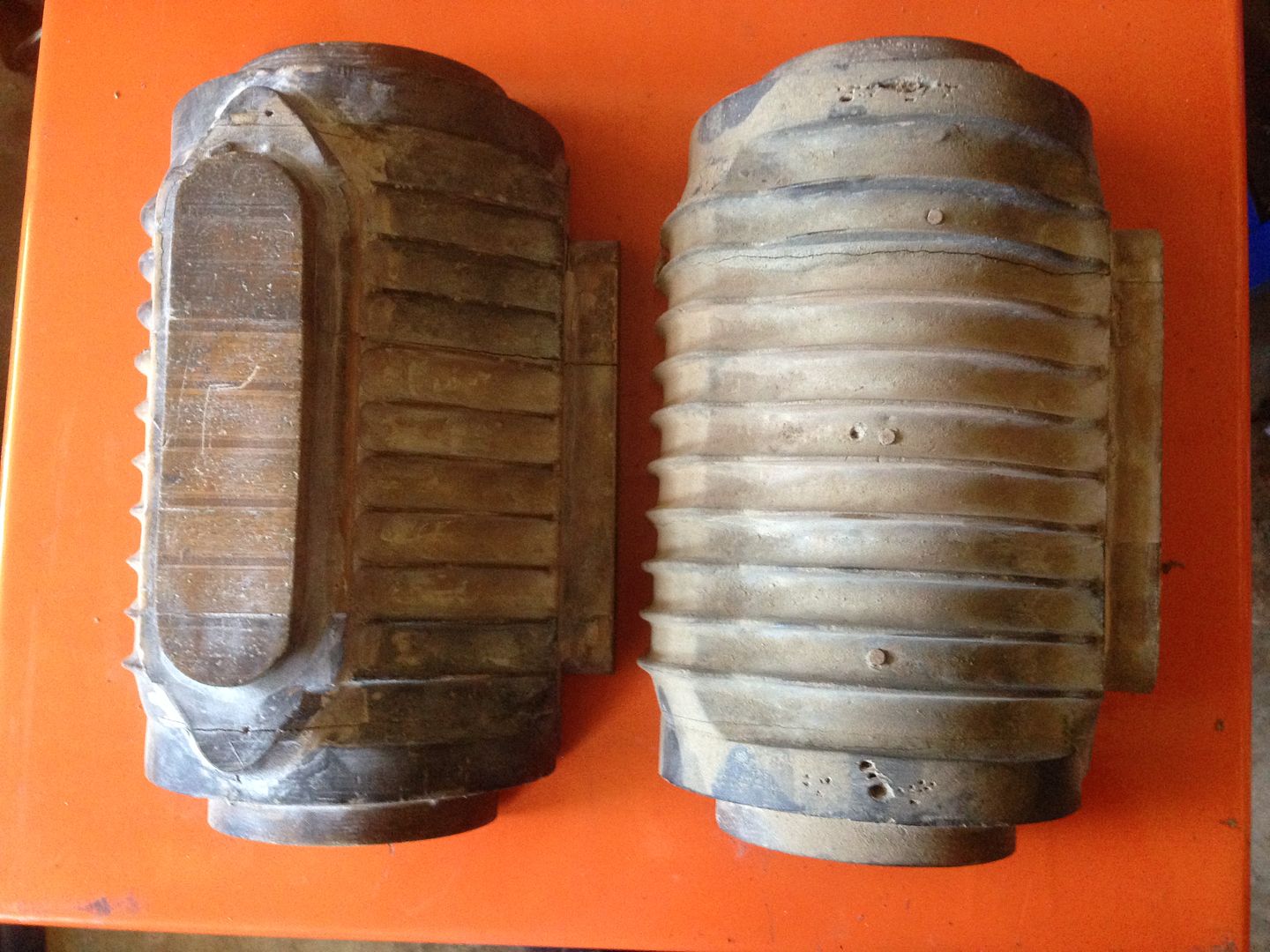 The main castings were cast elsewhere, while the machining and assembly was all completed in the engineering factory. With the move from Glenelg to Somerton Park a privately owned foundry was located at the rear of the property, and they provided the castings. Early Wray superchargers were manufactured with cast iron liners, which were machined and honed. The liners were changed to a seamless steel design which reduced previous issues with liners cracking and/or breaking (we’ll hear more about one such event later). The steel liners were not treated or honed. The liner shown below (photos: Fred Radman) is an early one. The ports (oval slots) are parallel to the casing, and were referred to by Wray as Mark 1 porting. Norman superchargers have similar parallel porting. |
|
|
|
|
 Logged
Logged
|
|
|
|
|
Harv
|
 |
« Reply #309 on: December 08, 2015, 12:42:50 PM » |
0
|
 The steel pointer in the Fred’s photo below is indicating the wear in the bridge pieces between the oval ports (inlet side).  Later Wray liners had Mark 2 diagonal porting, which imparted a wiping action to alleviate the wear. Judson superchargers used a diamond shaped port for similar reasons. The Mark 2 porting can be seen by the diagonal bridges in the photo below (photo: Fred Radman): 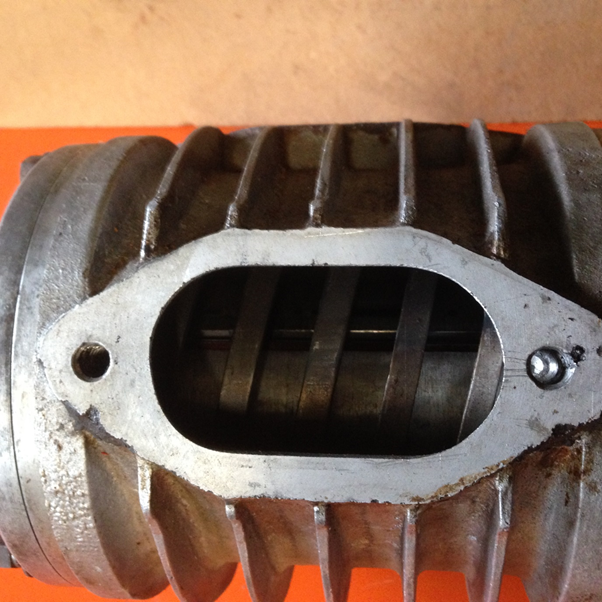 The early model Wray superchargers had a cast aluminium rotor. Due to a lack of quality control at the foundry these rotors had porosity in the castings, which caused a lack of strength. They occasionally exploded at high speed…. and sometimes at not so high speed too. 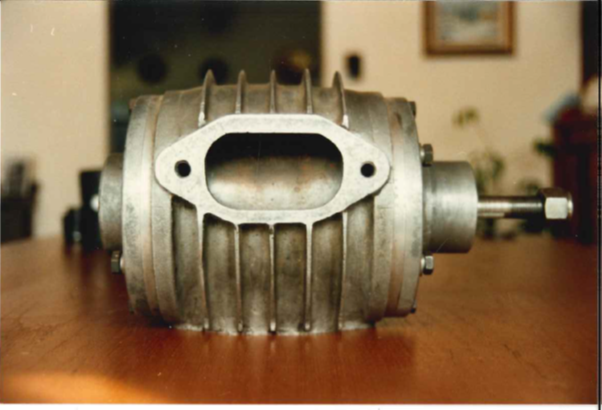 The photograph above (photo: Fred Radman) shows an early supercharger owned by Fred Radman (we’ll meet him later in this anecdote), complete with cast rotor. The supercharger later split a rotor, though after cutting the drive belt the car was able to be driven home. With the end plate off there was visible wear to the vane slots, with the ends starting to flare out. The split rotor is shown in Fred’s photo below - the crack originated at the corner of the slot, which is a stress riser: 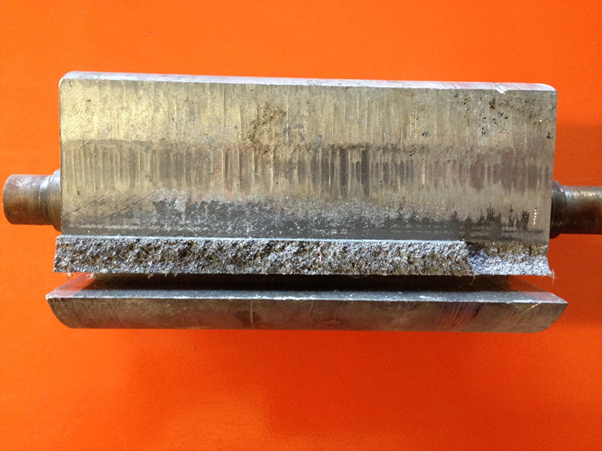 In about 1970 the cast rotors were no longer produced, and instead aluminium billet extrusions were used. This reduced the frequency of rotor failures, though is no guarantee – some of the later rotors have cracked. The photo below, from John Bowles, shows a later rotor with a crack under the black “C” mark: 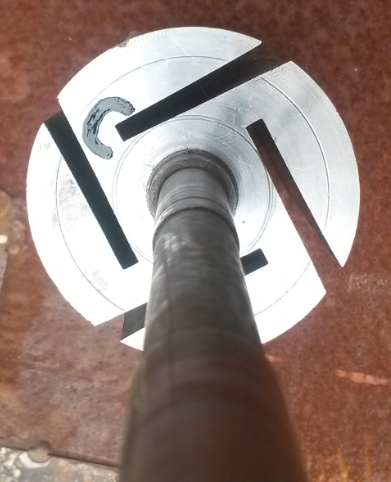 The rotor drive shafts were generally of a standard length. Custom orders were catered for with longer shafts and drive plate end castings with longer snouts to support the longer drive shafts. Wray supercharger rotors employ four vanes made from fibre reinforced Tufnol (Tufnol, like Bakelite, is a cotton reinforced phenolic resin). The vanes were cut to a rough size, then ground to final size (length, width and thickness) on a tool and cutter grinder. No springs or grooves were used with the vanes. The photo below, from Fred Radman, shows the vane profile: 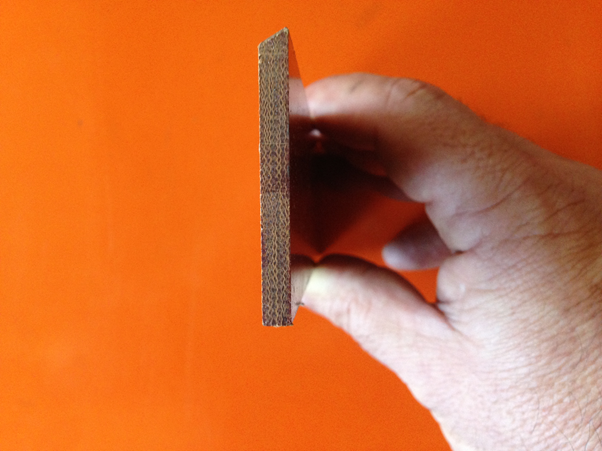 Lachlan Kinnear remembers a discussion with Alec Rowe quite a few years ago. The conversation discussed the first Norman superchargers, and how Eldred had found a Judson supercharger. Apparently Eldred measured the critical dimensions to make the initial Normans. Whilst the Wray rotor dimensions are similar to Norman and Judson superchargers, they are not identical. The measurements may have been changed slightly by Eldred, or may have been scaled from photographs. Dimensions for the Judsons, Wrays and a range of Normans are shown below:  |
|
|
|
|
 Logged
Logged
|
|
|
|
|
Harv
|
 |
« Reply #310 on: December 08, 2015, 12:43:33 PM » |
0
|
The Wray supercharger drive end was fitted with two 6303 sealed single race ball bearings and a spacer sleeve retained with a circlip. The non-drive end used one 6303 bearing retained with a circlip and a welsh-plug end cover. Note that this is similar to a Judson (which uses a single 6203 ball bearing at each end of the rotor), but different to a Norman, which has a single race ball bearing at the drive end and a roller bearing at the non-drive end, which slips the inner and outer races to allow the rotor to grow under heat. The Wray, like the Norman, uses a single lip seal (TC12420 for the Wray, with the Normans using a variety of seals) to seal the drive end. The Judson is different, using two seals on the drive end and a single seal on the non-drive end. The Wray supercharger cast end plates were machined in a lathe. The clearance between the rotor and the drive end plate was set and the non-drive end clearance governed by the expansion of the rotor and housing. The expansion of the alloy rotor and the housing was similar and if the initial manufactured clearances were correct there were never any issues of seizing. This again is different to the early Normans, where there is significant difference in the growth of the steel rotors and alloy casings. Wray Engineering manufactured various cast aluminium manifolds which were supplied with the ‘kits’ and these along with other designs were also available to customers to assist with other variations for individual installations. Otherwise, fabricated steel manifolds were easy to manufacture. The ‘kits’ did not have relief valves, though many of the later custom installations incorporated the valves, which were manufactured in the workshop. The image below (photo: Fred Radman) shows the T96 intake manifold. Note that the same casting is used for a single-barrel downdraft carburettor (the upper image), or a sidedraught carburettor (the lower image). The sidedraught option is effected by cutting the casting off at the flange. The pattern was originally made to suit the downdraught carburettor and then was modified at a later stage 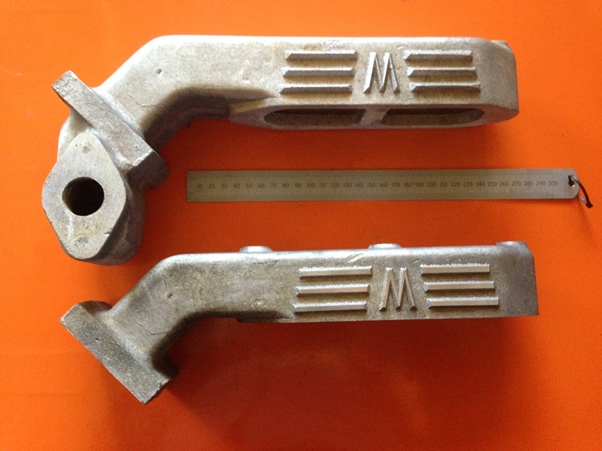 Two-stroke oil was generally added to the petrol in the fuel tank for lubrication. Some customers added ‘oil injectors’ (like the Marvel Mystery Oiler used in Judson superchargers) to the inlet manifold to negate the need for premixing oil/petrol in the fuel tank. Typical Marvel oilers are shown below (photo: Fred Radman). Water injection was also used in some installations. 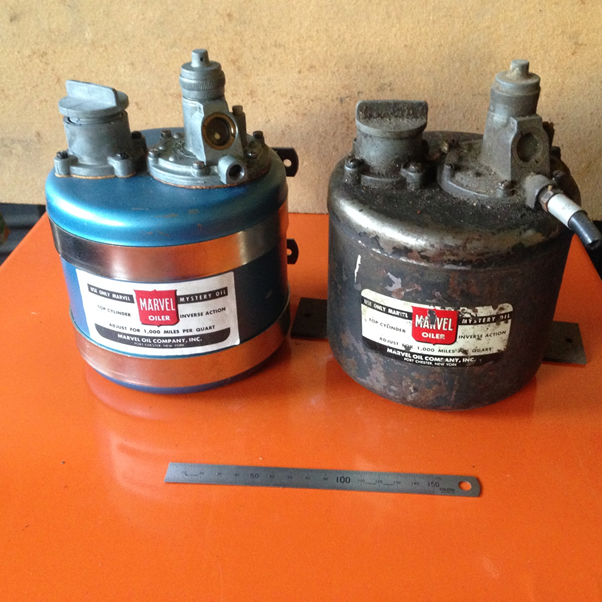 Various carburettors could be used; the preferred choice for later Holden installations being a 2” SU carburettor and a downdraught for the BMC kits. Manifolds could generally be machined or modified to suit various choices of carburettor. The photo below shows a T96 supercharger with a Weber DCOE adaptor, whilst the second image shows a fabricated Weber DCOE to L60 adaptor (photos: Fred Radman): 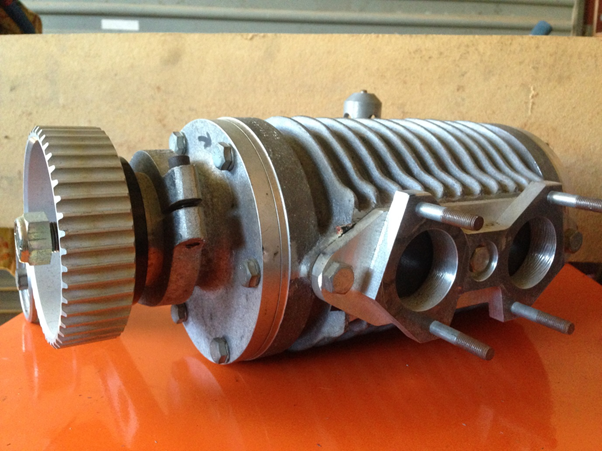 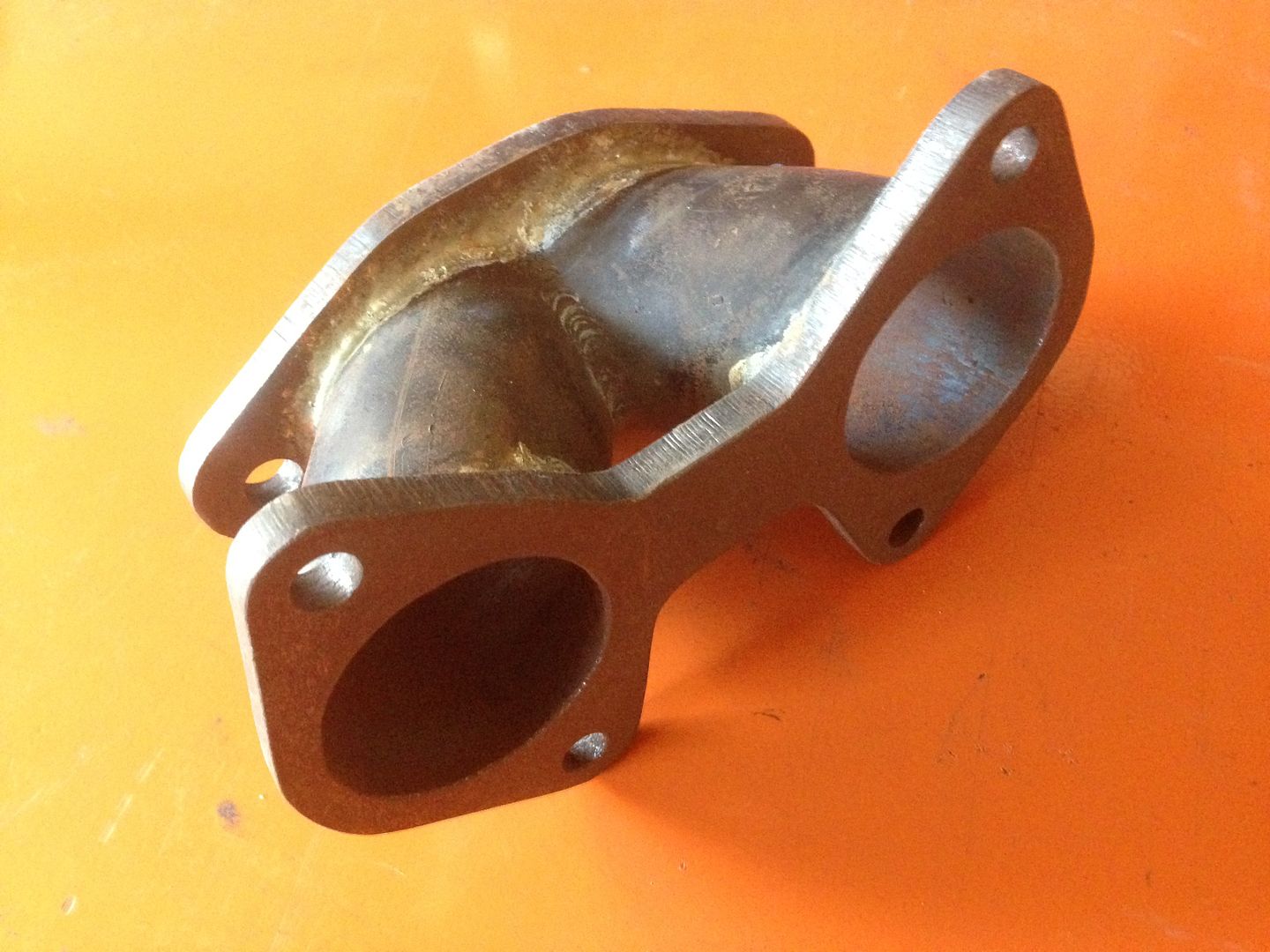 The engineering drawings below come from Fred’s collection: 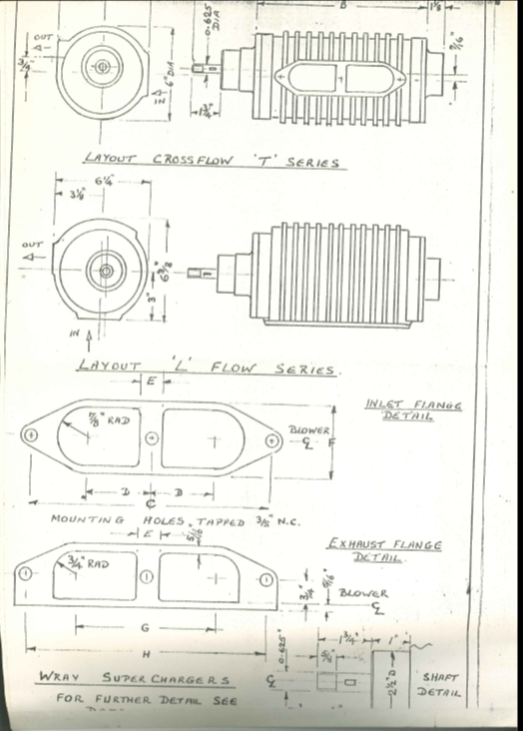 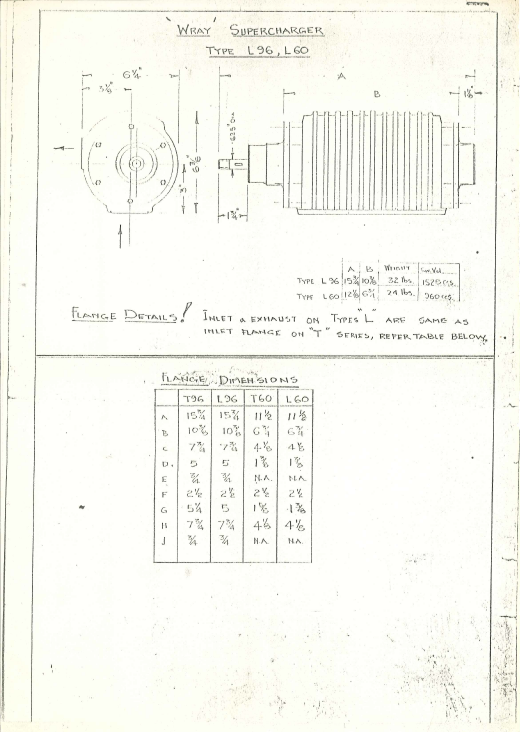 |
|
|
|
|
 Logged
Logged
|
|
|
|
|
Harv
|
 |
« Reply #311 on: December 08, 2015, 12:44:17 PM » |
0
|
4. Wray-blown Vehicles Wray superchargers were fitted on a very wide range of vehicles. The first was Mike McInerney’s FJ, shown below. 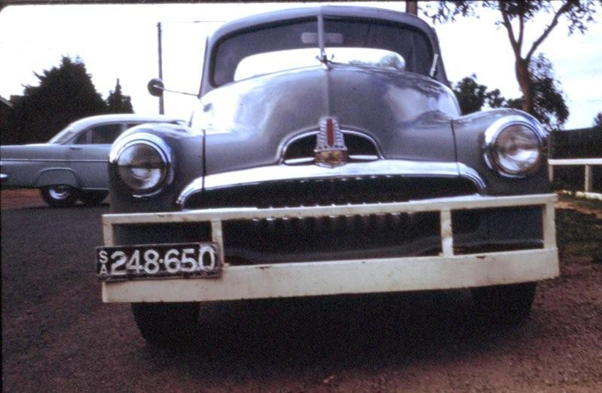 The FJ was Mike’s first car, an ex-Department of Supply 132.5ci FJ Holden utility (in Maralinga Gray colour) which he bought at auction in 1960 for £165. The Department of Supply was an Australian government department that existed between March 1950 and June 1974, and managed aluminium production, tin import, control of atomic energy materials, supply of war material, building and repair of merchant ships and promotion and production of liquid fuels. Mike used the vehicle for milk-rounds from 1962 through 1965. In 1965, with the Wray works still operating from Glenelg, Mike fitted the first prototype large Wray supercharger. An adjustable oil injector was used to provide lubrication, with the bottle mounted on the scuttle. A sight glass was fitted to the injector to show the flow of straight 30- weight engine oil. Mike milled the head to take Holden 179ci red motor stellite valves (10% larger on the inlet and 5% on the exhaust than the standard grey) and lowered the compression ratio. Mike also milled and fitted main bearing cap bridges to the crank. The three-speed crashbox had a floor shift built by Alex Rowe (a joy to double clutch), 11” disc brakes on the front (a NSW-based company made them to fit onto the standard FJ Holden 15" wheel hubs), Dunlop R5 racing tyres, and ladder braces to strengthen the subframe to the chassis rails. The engine could pull from 10mph through to a top speed of about 90 mph in top gear, was very quick off the lights and very flexible throughout the rev range. The engine did not have a ‘big’ camshaft. It had a sign on the back, opposite the number plate – “Supercharged by Wray”… reminiscent of the “Supercharged by Norman” emblems of the era. Mike did not have a relief valve fitted between the supercharger and the cylinder head, giving no overpressure protection in the event of a blower bang. Following a bang in Mildura, the blower cracked the cast iron liner bridges which act like a grille across the supercharger discharge port. The bridge pieces ended up in #6 cylinder of the grey motor. Mike disconnected the blower belt and drove back to Adelaide at low speed (some 400km…). On pull down of the grey, there was a damaged #6 piston and some hammer damage to the valves and valve seats. On tear down of the blower, it was noted that the rotor vane slots were wearing. The supercharger was rebuilt using a tougher alloy for the rotor and the casing liner was engineered from bore casing steel. The sleeve was pinned using a dowel with the front end plate as the locator. It was decided to follow the wisdom of Alex Rowe and mix two-stroke oil (about 2-2.5%) with main fuel for vane lubrication. The oil injector was deleted, and a relief valve installed. Mike took the ute to Darwin in August of 1968 and sold her in December 1969 to buy a brand new 1969 Holden V8 4-speed ute. The photo below is of the Wray fitted to Mike’s FJ, running a single grey motor Stromberg carburettor (photo: Mike McInerney). 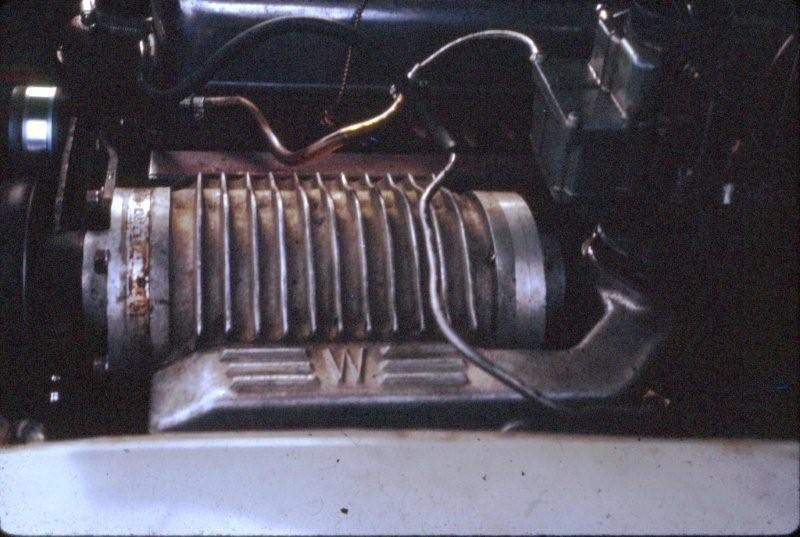 Note the “W” and fins cast into the inlet manifold. A few months after Mike supercharged the FJ, Ian Robinson (Ronnie) installed the smaller model Wray supercharger on his street-driven 1310cc Mini Cooper S. The Mini is shown below: 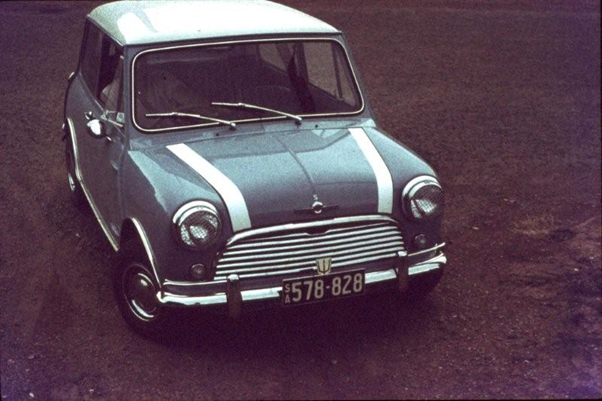 |
|
|
|
|
 Logged
Logged
|
|
|
|
|
Harv
|
 |
« Reply #312 on: December 08, 2015, 12:45:10 PM » |
0
|
The photo below shows the interior of the Cooper… with a suspicious looking boost gauge on the far right hand side of the cluster . 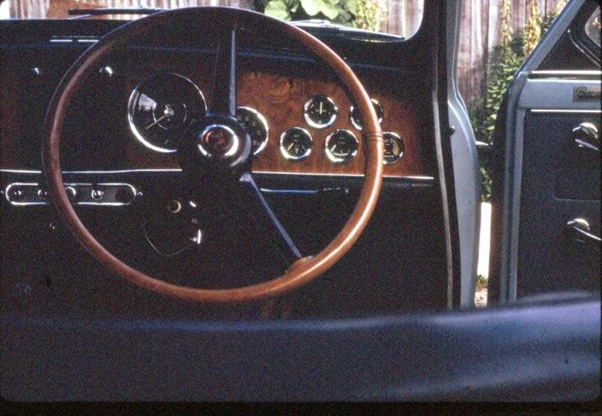 The Mini’s engine is shown below. 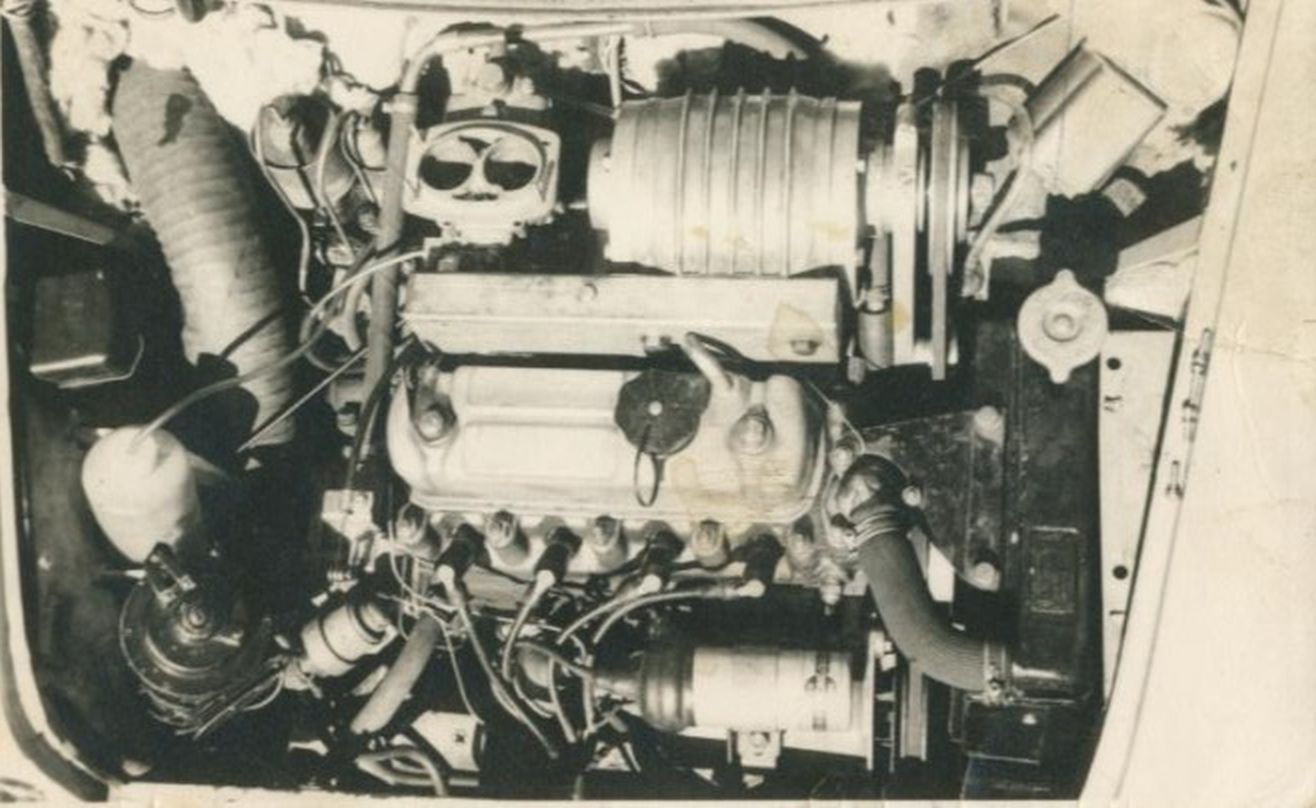 Robbie had bought the Mini new, having to wait twentyone weeks for the vehicle to be imported from the UK. The car was the 6th in South Australia. Robbie had a penchant for speed, with the brand new (and as yet naturally aspirated) Mini clocking some 90mph down Pirie Street, Adelaide in the early hours of his first day of ownership. On fitting the supercharger, the car was found to run hot. A second radiator was installed in what was becoming a very cramped engine bay. The twin down-draught carb shown in the photo above would later be replaced with an 1¾” SU from a Jaguar. The SU’s needles were turned down on a lathe to suit the increased fuel load. The Mini was fed a diet of 115 octane fuel from BP, along with upper cylinder head lubricant added to the tank. A decompression plate was manufactured from 1/8” steel plate, with XW Falcon pushrods being used to bridge the increased distance. The Wray-blown brick was quite a weapon… Robbie would own the machine for three years, and only hold his license for a few months in that time. The locals would pause in sipping their pints at the local hotel as the Mini spun 360º on it’s way past from the train station. A journey from Adelaide to Mildura (some 400km) was completed by the brick in 3¼ hours… the 75mph (120km/h) average speed probably had something to do with the empty fuel tank five miles from the journey’s end. The local Police were equipped with Valiants, with Robbie keeping them busy. One journey over the ranges had the Mini clocked at 130mph, followed by 115mph past the local shopping centre. Slowing down over the railway tracks, Robbie made a wrong turn and ended up in a dead-end. The Valiant, in hot pursuit, was not as agile as the Mini and failed to negotiate the last corner. The Police, climbing from the damaged Valiant, were none too amused, and decided Robbie would probably be better off walking for the next 5½ months. On getting his license back, some testing was in order. A large model Wray had been fitted to a bloke’s white Mark 1 Cortina GT. This engine was a five-bearing 1500cc with four-speed gearbox. The Corty was almost too hairy to drive, easily breaking traction in first gear, especially if the road was wet. The “test run” between the Cortina and Mini in the local hills got a little out of hand, with the Cortina ending up on it’s roof on the train tracks. Robbie would be walking for another two years two months after that drive. Robbie’s wife also pushed the car hard. Refuelling the car at the local service station, the attendant refused to add upper cylinder head lubricant to the tank. A phone call had to be made to Robbie to prove that his wife was correct. When the tank was full (with the required lubricant too), the Mini departed at some speed… leaving black tracks for quite some distance down the street. Another incident saw the Mini clocked by amphometer at some 75mph in a 30mph zone. This also didn’t impress the local Police (though the “Unmarked Police Car” sticker on the rear window may have had something to do with that). Sadly, the Mini was eventually written off. Robbie can also remember a Datsun 1600 that received a Wray supercharger. The car was used to impress potential customers. On launching the Wray-blown Datto, non-believers would be asked to open the doors on the moving car. The supercharged engine torqued the body so much that the doors could not be opened. Greg Pill built a Wray-blown XR Ford Falcon stationwagon, shown in the images below (from Greg): 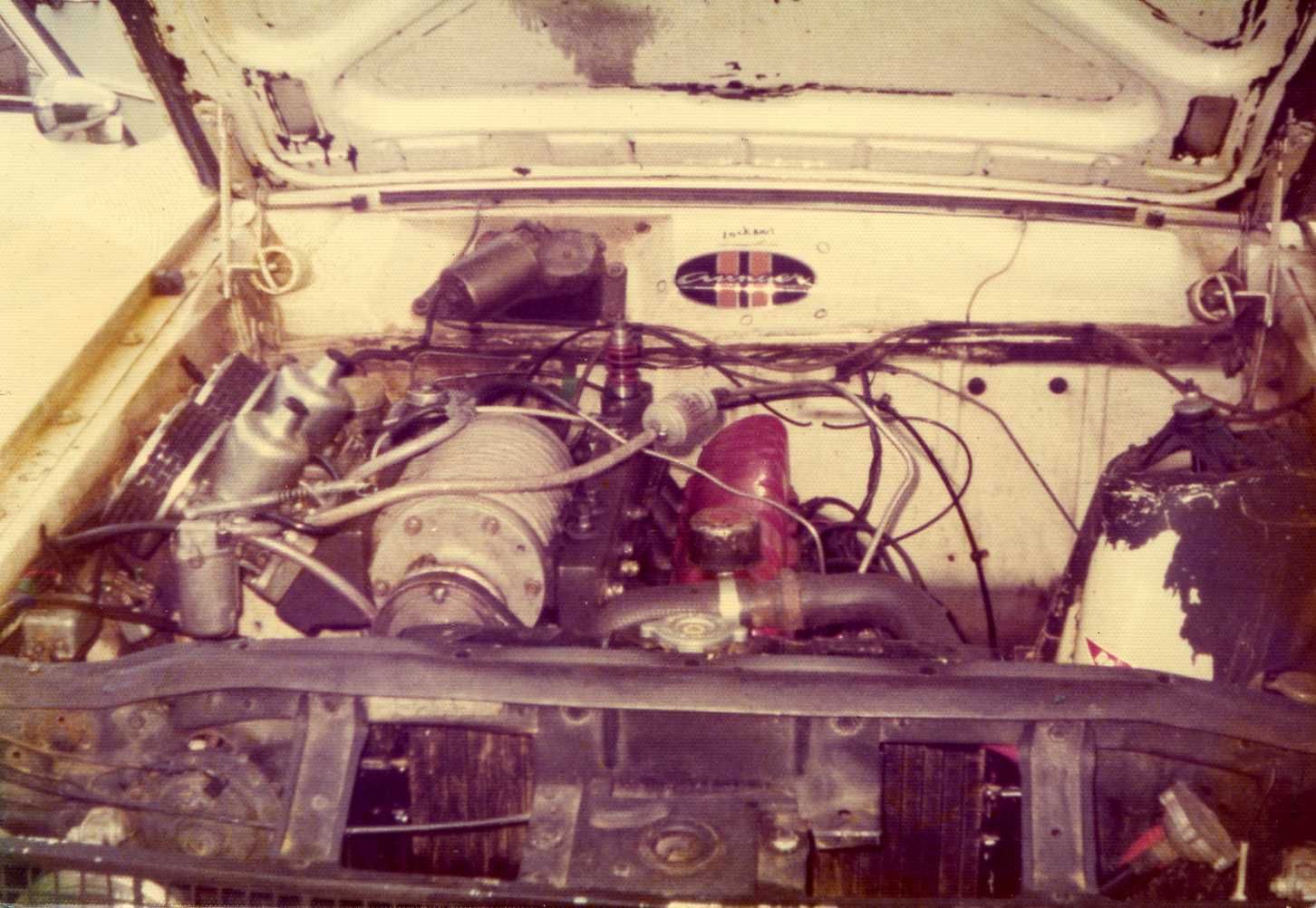  |
|
|
|
|
 Logged
Logged
|
|
|
|
|
Harv
|
 |
« Reply #313 on: December 08, 2015, 12:45:48 PM » |
0
|
Greg’s Falcon ran the 170ci Pursuit straight-six engine, which was available from 1961-1972 (XK, XL, XM, XP and XR Falcons), and was good for up to 111BHP in naturally aspirated form. Greg’s 170 used short deck height pistons to lower the compression to 8.25:1, a worked cam, extractors and a ported and polished head. Two additional mounting plates were welded to the cast head which provided three ports. Greg utilised the larger of the Wray superchargers, mounting it via a box manifold with mounting bolts passing through the pressure envelope and sealed with rubber washers. The supercharger was fed by twin 1¾” HD SUs with the angled main body (the inlet manifold mounting face is equally angled to ensure the float bowl orientation is level). A double v-belt from the crank drove the water pump and alternator. The water pump pulley was machined to suit a gilmer belt which then drove the supercharger. A little unorthodox, but a smart way to solve the problem of fitting everything within the confines on the right side of the motor. A relief valve was fitted to the top rear of inlet manifold. The Wray delivered some 14psi of boost, and was street driven and never raced. Greg sold the Ford without the supercharger. The photo below, which I have taken from the internet, shows a Wray fitted to an unknown 1990’s rotary vehicle using twin HIF7 SU’s. I suspect this is John Basset’s (from Southern Fuel Injection, and linked to Globe Industries) RX3, which later was sold in Western Australia: 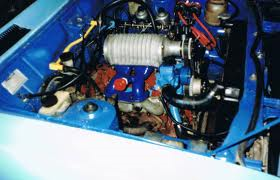 The smallest engines installations were fitted with Wray superchargers were two speedway motorcycles installed in 1976 for Bob Cronin. The first vehicle was a Birmingham Small Arms (BSA) Rocket 3, running on methanol. The BSA was Bob’s first venture into speedway racing - with no previous experience for him and his passenger on a ‘home made’ bike they were very competitive. The BSA Rocket 3 (a.k.a. Triumph Trident) was a three cylinder 750cc air-cooled pushrod overhead valve engine coupled to a dry plate clutch and four speed gearbox (some 200-odd were lucky enough to get a fifth gear). Over 27,000 Rocket 3/Tridents were produced during its seven-year history… though only Bob’s two would be Wray-blown . In the image below (photo: Greg Pill), the Wray T96 supercharger can be seen nestled below where the fuel tank and seat join. 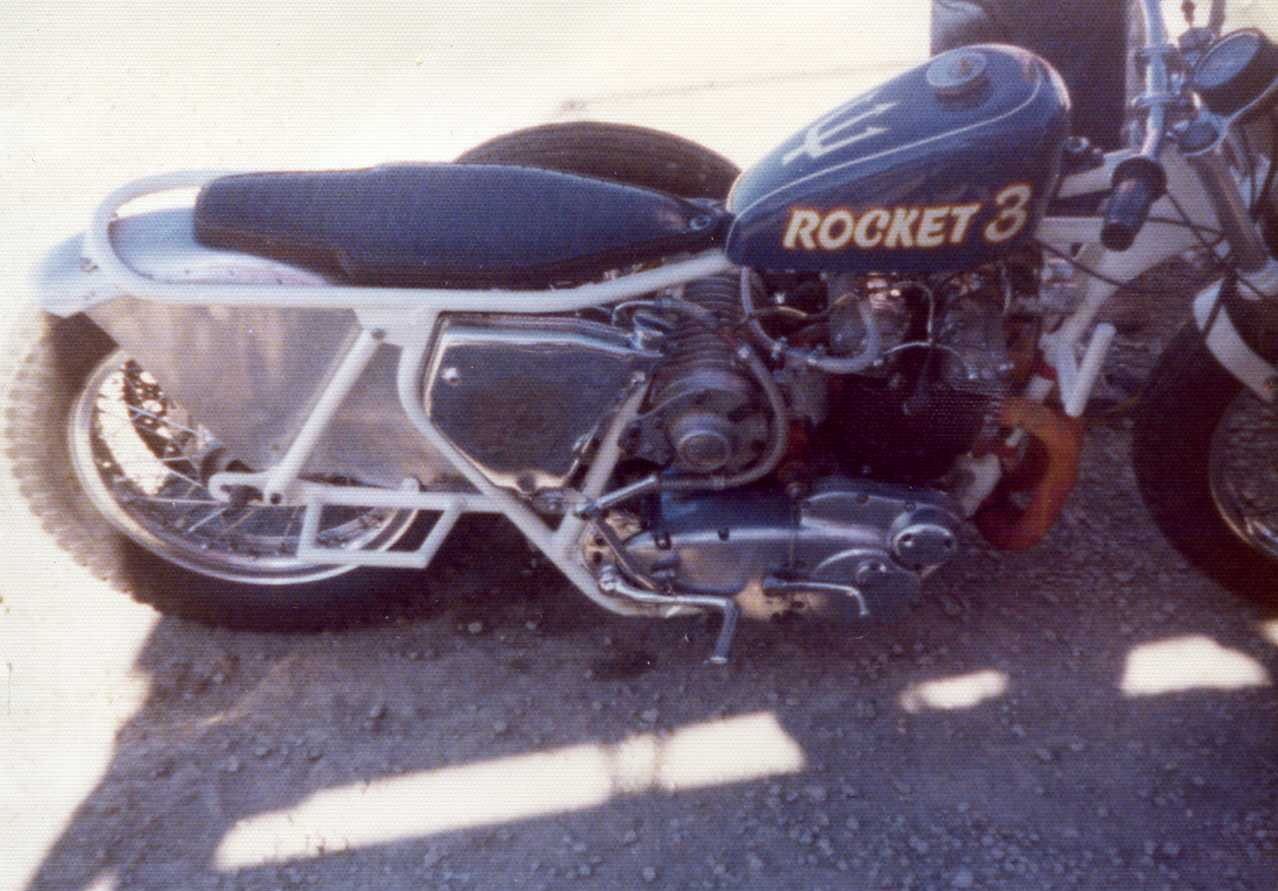 Bob’s second outing into home-made crotch rockets was powered by a sleeved-down 750cc Volkswagen engine. Bobs theory was that if the test engine worked in competitive service then a stronger, better engine would be built using after-market crankshaft, crankcase and heads. Initial engine was a 1200cc (40hp) crankcase, modified 40hp heads, custom cylinders utilizing 750cc Suzuki water-bottle pistons giving a capacity of 750cc. The Wray T96 supercharger was installed and can be seen in the image below (photo: Greg Pill), nestled below the fuel tank. 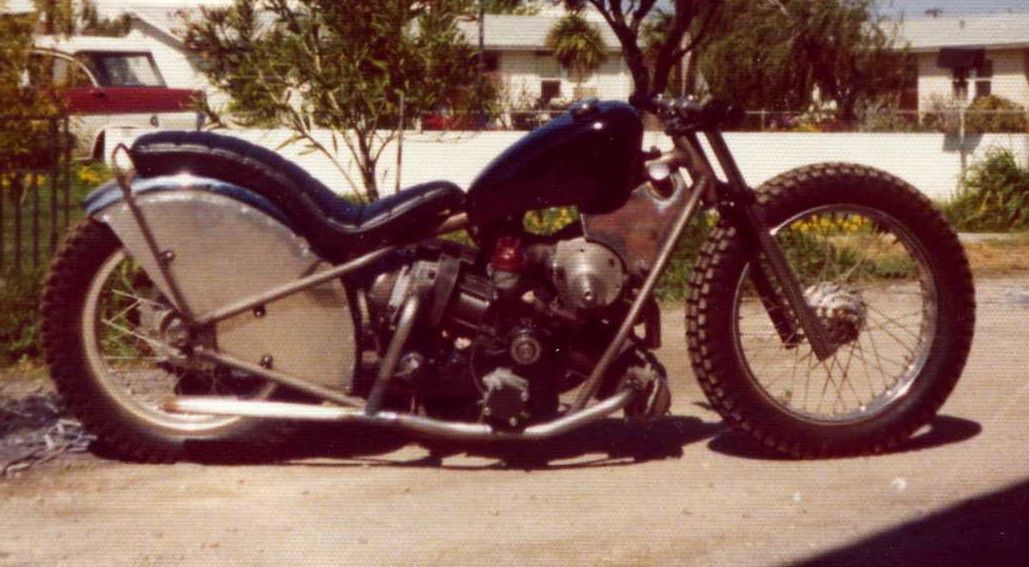 The bike had a very low centre of gravity, light weight and high power. Both of Cronin’s Wray-blown speedway outfits were tested and raced at the Rowley Park Speedway in Adelaide. They were very successful due to impressive power outputs. Unfortunately they were too successful; culminating in 'blown motors' being banned. The Western Australian MG fraternity, recipients of the last batch of Wray superchargers, remain strong users of the machinery. Kevin McMahon runs a small Wray on his MG TC & Y Special (shown below in Kevin’s photo, followed by an image I lifted from the internet), as has Peter Compton, Rob Bodkin, John Bowles and Ed Farrar. 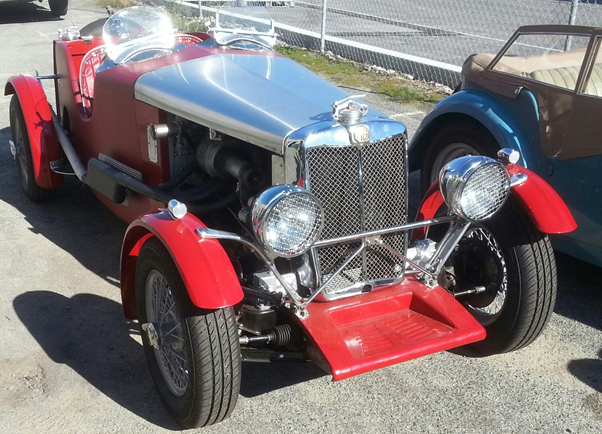 |
|
|
|
|
 Logged
Logged
|
|
|
|
|
Harv
|
 |
« Reply #314 on: December 08, 2015, 12:47:26 PM » |
0
|
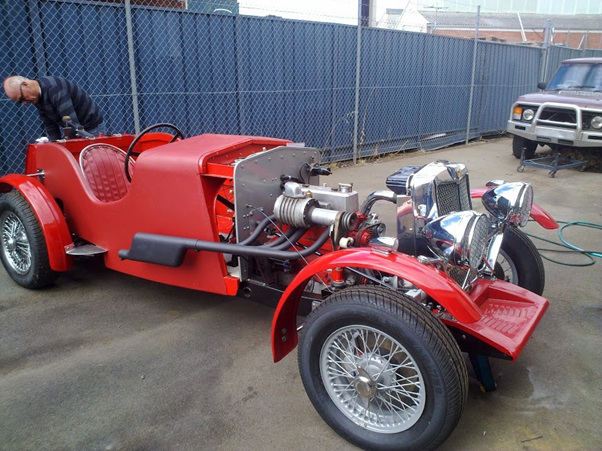 The Wray on Kevin’s Special was reworked by John Bowles, who machined the nose so that the bearings could accommodate the front engine attachment. Ed Farrar machined the vanes. The Special runs around 7½psi boost, indicated by a Spitfire (aeroplane) boost gauge. The video below shows Kevin’s vehicle at the 2015 Northam Flying 50: https://www.youtube.com/watch?v=NKT8oyDycEEThe Special sees active race service, having beat both a Morgan and a Mazda MX5 at Barbagallo Raceway prior to blowing the gasket between the supercharger and inlet manifold. Don Tosler (Toesler?), from the Rostrevor area of Adelaide built a mid-engined (Wray-blown 16TS) Renault 750 as a sports sedan hill climber. Mid-build, CAMS changed the rules, banning mid-engined cars and forcing Don to campaign the car under a different class, competing at circuits that included Collingrove. Don Fraser from Revmaster Engineering Camshafts (Sheldon Street, Norwood) was a 1960s boat racer who had an Amilcar with a Wray-blown 2242cc Whippet motor. Amilcars were made in France between 1922 and 1938, whilst Whippets were made by Overland (Willys) in the US from 1926-1931. Don built the Amilcar in 1975. Pictured below (photos: Fred Radman) is the modified HS8 S.U. carburettor from the Amilcar. This used a Lord mount to hang the float bowl. The 3/16” jet is home-made… and somewhat larger than the factory 0.125”. The needle is stainless steel. 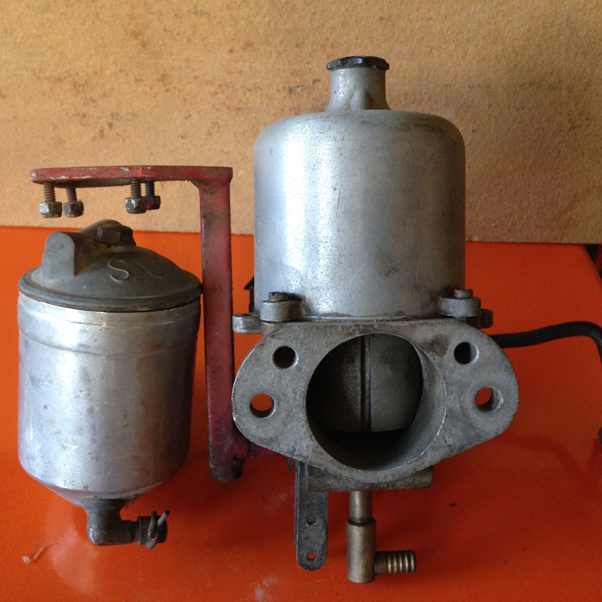 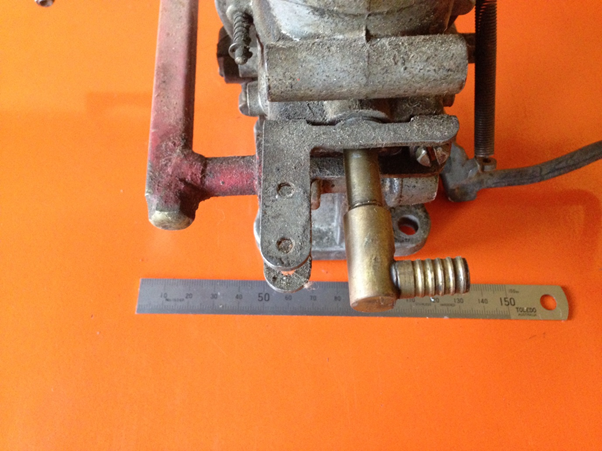 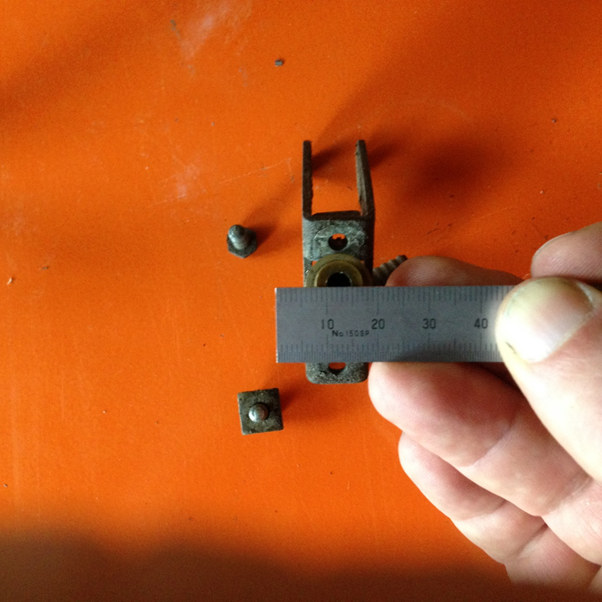 Don removed the carburettor along with the supercharger prior to sale as he was using it on his new set up. The Wray was subsequently replaced with a Roots supercharger with twin SU carburettors. The vehicle passed from Don’s hands to Neil Sullivan in 1999. The photos below show the Amilcar in it’s Roots-blown format:  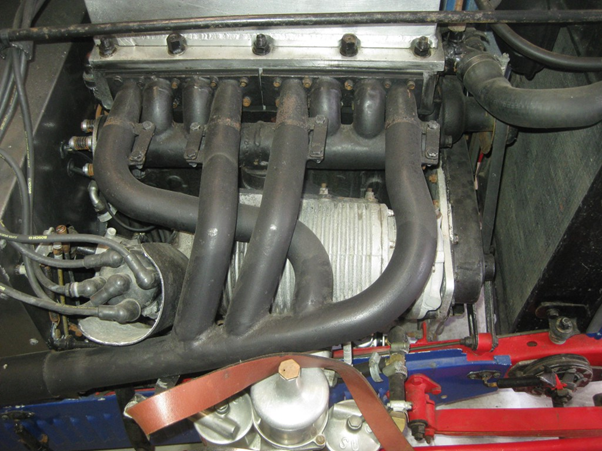 |
|
|
|
|
 Logged
Logged
|
|
|
|
|
Harv
|
 |
« Reply #315 on: December 08, 2015, 12:48:10 PM » |
0
|
Pictured below (photo: Dave Linton) is Dave Linton’s 1275cc Wray-blown Moke. In the late 1980’s Fred Radman offered Dave a Wray L60 BMC “A” series supercharger kit to install into the Moke. A fresh motor was built, overbored to 0.020” resulting in 1293cc and a compression ratio of 9.75:1. A custom camshaft was re-ground via Chris Milton using the Special Tuning 731 timing. However the lobe centre angle was reduced to 100º. The additional overlap enabled combustion chamber exhaust gas purging with the incoming compressed air/fuel mix. The Moke firewall was modified to allow the drive belt to run directly to the bottom pulley (see the modified red lead painted piece of box chassis section in the photo below). This placed the belt tensioner on the correct side (slack side) of the belt. The alternative (without the box section) places the tensioner on the drive side of the belt. A standard Moke harmonic balancer had a second vee groove cut into it to provide drive for the supercharger. After experimenting with a downdraught D5 S.U. carburettor and a Reece Fish, the carburettor was changed to a downdraught Stromberg as used in a Holden 186 red motor. A variable main metering jet was installed on the carburettor to adjust the fuel mixture. The Moke used a Marvel inverse oiler on the far side of the engine bay (complete with synthetic two-stroke oil). At full noise, the setup generated some 8–9psi of boost. Dave used the Moke daily for six months of the year over a couple of years, as Adelaide has pleasant weather from October to March. The main issue Dave experienced was that of carburettor icing during prolonged light throttle with cold ambient air temperature. Soon after installation the rotor failed, though cutting the fan belt enabled the Moke to be driven home to be repaired. Once the rotor had been replaced there were no other issues with the supercharger. The Moke competed at the Collingrove hillclimb and street drags at AIR. (Adelaide International Raceway). It was driven to the Australian Motorkhana Hay Nationals at Hay, NSW, with the Moke double-entered for two drivers. This is a round trip of some 1300km, with the carburettor icing issue being the only problem experienced on route. 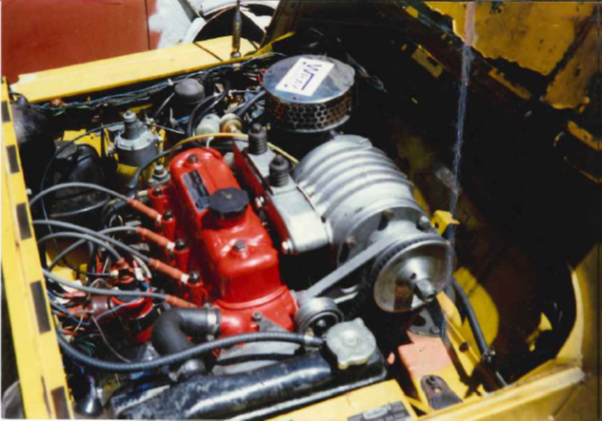 Note the Wray sticker on the air cleaner. Fred had some of these made up in later years (photo: Fred Radman): 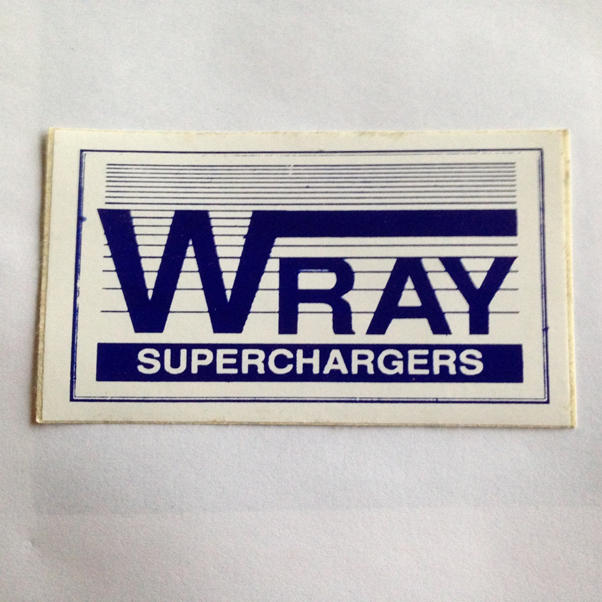 The photo below again from Dave Linton shows a T96 on a 1275cc Mini motor. The Wray manifolding has a Shorrock blow off valve which was found to seal better than the earlier plate type. Note that the manifold casting has been cut back to allow for a sidedraught carburettor. 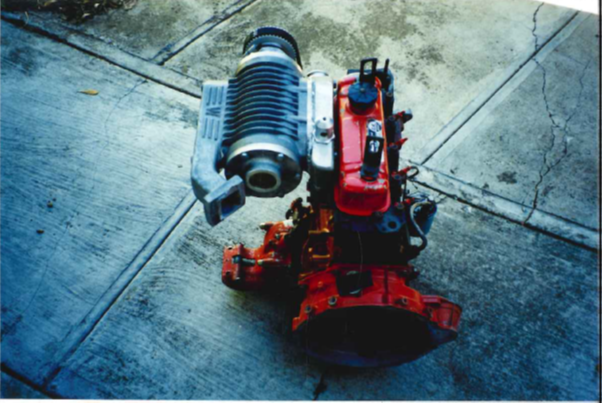 More photos from Dave below:  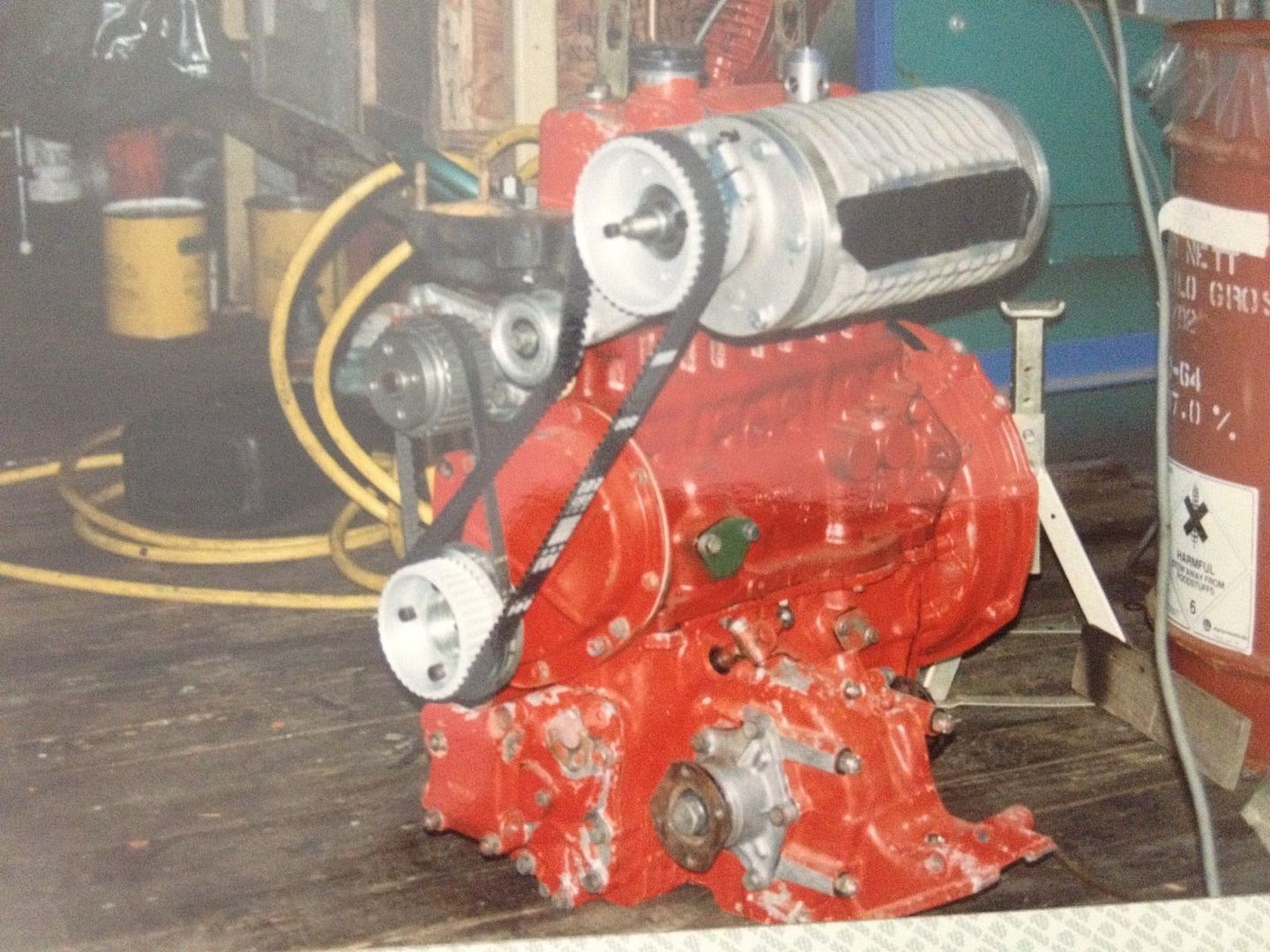 Lachlan Kinnear has a Wray on a vintage Vauxhall, whilst John Payne has a Wray on a MG Type 2. Lachlan’s Wray has the earlier cast rotor, and was earlier fitted to a Holden red motor from Mannum, South Australia. Lachlan also has the original Wray belt tensioner arm and inlet manifold. |
|
|
|
|
 Logged
Logged
|
|
|
|
|
Harv
|
 |
« Reply #316 on: December 08, 2015, 12:48:51 PM » |
0
|
Mike Adi’s (Advance Headers 16 Braeside Avenue Holden Hill South Australia 5088) Gamma Special Goggomobil was initially configured as a Wray-blown VW engine. The vehicle then moved to a Norman, and later to a Toyota (Aisin) SC14 running around 20psi of boost. The Wray was later sold to Brian Paige who fit it to a Simca. The photos below are from Mike: 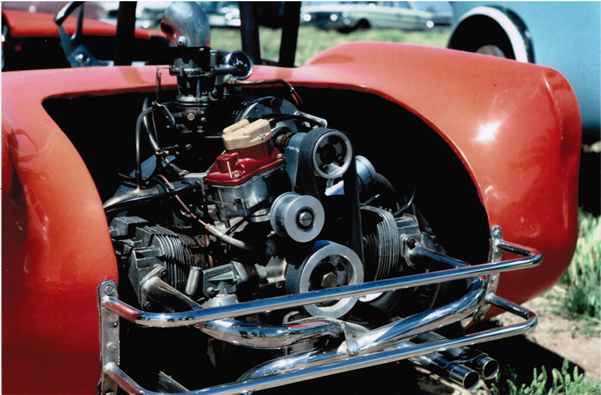 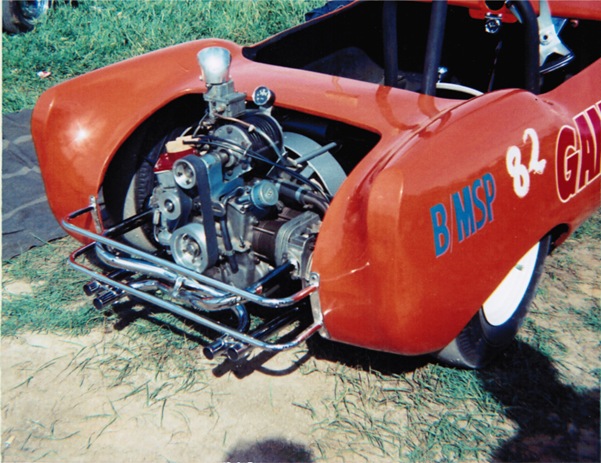 The Aisin-blown vehicle is shown below at Whyalla drags (I have lifted the images and video from the internet): 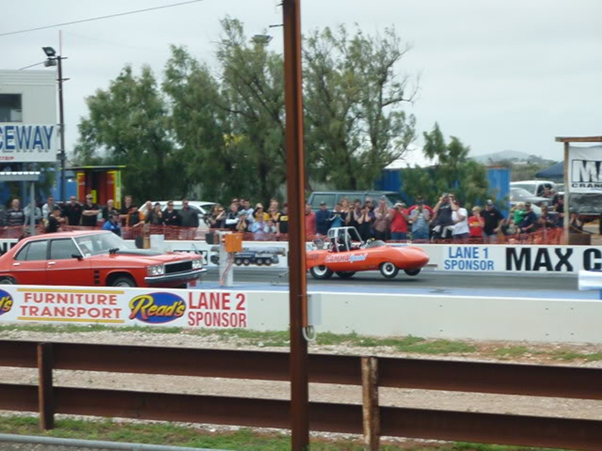  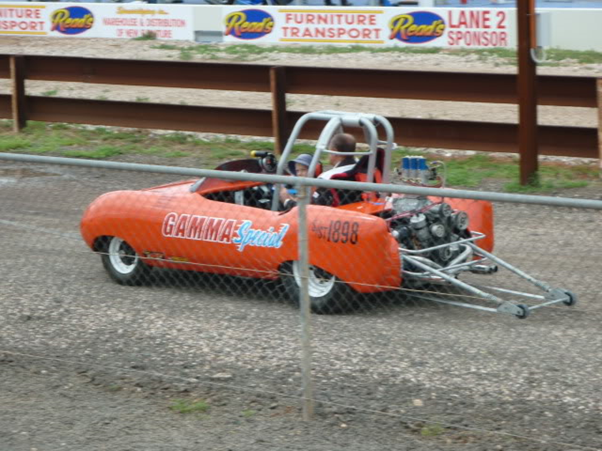 https://www.youtube.com/watch?v=vff3f9X4Ik4https://www.youtube.com/watch?v=9hzBd4qzrLo https://www.youtube.com/watch?v=vff3f9X4Ik4https://www.youtube.com/watch?v=9hzBd4qzrLo… and finally, a photo from Mike of the rear of the car:  Rod O’Malley purchased a 1275cc MG Midget, and rebuilt the vehicle whilst still in his teens. The car was likely an ex race vehicle, notable through things like circles being painted on the doors (under layers of paint) and the sump plug being safety wired. As part of the rebuild, Rob acquired a small Wray supercharger in pieces. Having made his own manifolds to fit the Midget, the supercharger was reworked by Wray, with the casing rebored and the rotor slots tidied up before new vanes were fitted. The supercharger developed up to 5psi, though at any more loading the single vee-belt suffered slippage or breakage… Rod got around 500 miles from any given belt. Water/methanol injection was added to the Midget. The logbooked Midget would go on to serve as Rod’s road and track car, racing at circuits including Calder, Winton and Mallala. The car also saw service in motokahanas, though would only get 1½ events between gearbox failures. A 5.3:1 differential was later fitted for the Colingrove hillclimb, with the car starting in 2nd gear. Rod eventually sold the car through MG Sales ( http://mgsales.net.au/). |
|
|
|
|
 Logged
Logged
|
|
|
|
|
Harv
|
 |
« Reply #317 on: December 08, 2015, 12:49:30 PM » |
0
|
Ed Farrar has a Wray-blown Morris Minor ute, which has travelled some 400,000 miles in Ed’s ownership. The Wray supercharger kit was purchased through Don Hall Motors in Subiaco, Perth in the late 1970's or early 1980s. The Morrie originally had a relatively standard 948cc engine, with the Wray kit only taking a few hours to fit. The first test drive of the ute, with Ed’s father riding shotgun, showed the car to be very strong. After a lap around the block Ed pulled up in the nearest straight road… the local shopping centre. From a standing start, Ed warned his father that he would see what the Morrie would do wide open. Ed got wheel spin in first, which continued through second gear. By the time Ed found third gear he was doing twice the speed limit… an inopportune time to pass the local Policeman. After some 100,000 miles of service Ed was tiring of the engine taking a hammering from the supercharger. He purchased a complete Morris 1100s for $200, pulled the 1100cc engine and cut the end from the crank. A piece of steel was welded to the crank end and then machined to fit the standard lightened four-bolt flywheel and a Mk1 MG Midget clutch with uprated springs. In the following 300,000 miles the Wray-blown 1100 motor would only see one rebuild and one re-ring. As one of Ed’s friends found out, it’s not a good idea to bet the ute won’t do 100mph… Ed won the wager on the way to Esperance, leaving his mates brand new Honda Accord smoking at the side of the road from having tried to keep up. The Morris has seen some good loads over it’s time, often doing diving/camping duties (driver, two passengers, diving cylinders and compressor, tent, outboard motor and fuel tank, and 10’ boat on the roof). The Morrie has a new set of vanes fitted every 20 to 30 thousand miles depending on service conditions with the rotor being given a tickle each time. Ed carries a spare set of vanes under the seat in case of emergency. Images below of the Morrie are from Ed:   Ed has run his Wray’s hard over the years. While competing in a motorkhana at Mooliabeenee (north of Perth, Western Australia), he ran the Wray without an air filter. The gravel turned a freshly rebuilt supercharger to scrap in a single day. Ed has also made a number of spare rotors over the years. Ed targets a drive-end rotor-to-casing clearance of 0.002”-0.004” (Norman superchargers can be set to similar tolerances, though 0.010” is typical), and a non-drive end clearance of 0.018”-0.020” (Normans are typically 0.015”, with the early Type 65’s able to be set to 0.006”-0.008”). Ed has seen some Wray superchargers with as much as 0.080” clearance. The photo below from Ed shows a rotor being machined: 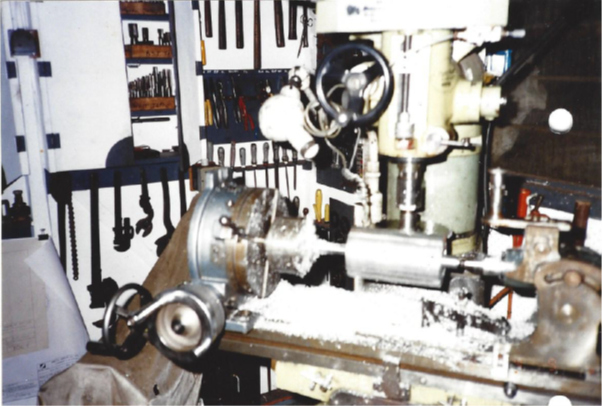 Ed and the WA MG crowd have also continued the development and upkeep of the Wray vanes. Harry Pyle has sourced vane material. At some time in the last ten years the vane material became a problem, probably because the thickness had been rounded to millimetres. Chris Foreman of Armstrong Energy (181A Star Street Carlisle, Western Australia, telephone (08) 93612761) is able to supply the thicker vanes but can also machine them to fit the rotor. He is also cutting diagonal grooves designed by Ed Farrar to help seat the vanes against the casing. Ed originally found the concept for the grooves in an American publication on sports car modification. The grooves are shown in the image below: 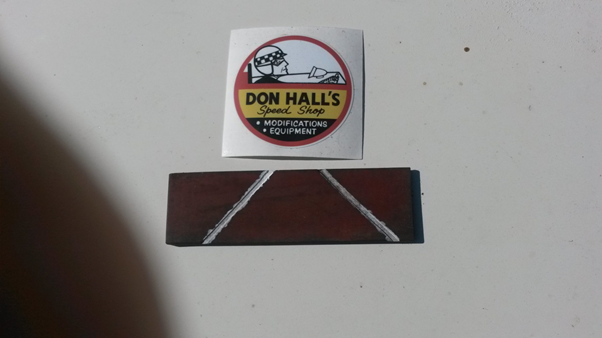 |
|
|
|
|
 Logged
Logged
|
|
|
|
|
Harv
|
 |
« Reply #318 on: December 08, 2015, 12:51:18 PM » |
0
|
Note that this is similar to the grooves used in the Norman superchargers produced by Mike Norman (see image below). Eldred’s machines did not use grooves.  The Farrar-modified Wray grooves are cut to one third of the vane thickness. The grooves are used to assist the vanes in being able to move in and out of the rotor. Sliding supercharger vanes are normally a “flop” fit, though may experience some changes in dimensions due to moisture, fuel properties or dirt. If the vanes become a tight fit, the oily environment they operate in may allow them to form a seal with the rotor. In this case, the vanes will draw a vacuum at the vane root as they try to slide out, or will build pressure at the vane root as they slide back in. The grooves allow the vane root to equalize pressure, allowing the vanes to slide freely. The slots also allow some flow of air/fuel/oil around the vane, helping lubrication. The Farrar-modified Wray grooves are sufficient to eliminate vane rattle at idle. At idle speed the centripetal force on the vane is low, and they can lose contact with the casing wall, giving a rattling sound. For the (Mike) Norman superchargers, the grooves are not sufficient to stop vane rattle, and springs are fitted under the vane (the square notches in the yellow vane show above are used to seat the springs). The Farrar-modified Wray grooves are angled, helping to sweep out any debris arising from vane wear. Ed also has a complete spare Wray supercharger, and rebuilds Zoller sliding vane superchargers. Arnold Zoller (1882-1934) was Swiss machine technician, and worked for Fiat for several years designing racing engines before co-founding a business marketing the Nazzaro car. From 1917 he worked for Argus Motoren, focussing on developing the supercharger, particularly for two-stroke engines. This lead to the invention of the Zoller sliding vane supercharger in 1927, which were used in vehicles including BMW, DKW and NSU. Another Wray-blown Morris Minor was owned by Phil Evans from the Morris Minor Centre, Adelaide. His ute ran a standard 948cc motor with extractors and the supercharger, and was used as the regular pick-up and delivery vehicle for the business. The photos below, from the owner, show Tim Billington’s T96 Wray. This machine was purchased by Tim from a Mr Booth of Cooroy, Queensland around two years ago. It is an early Wray, with the early Mark 1 type porting. The manifold face that can be seen with a looooong stud hanging out of one hole was later modified by Wray to have four smaller bolts in addition to the three shown on Tim’s. Tim’s fabricated tensioner is not a factory (cast) Wray unit. On the periphery of both the casing a hole is noticeable at about the one o’clock position. This hole is used to install a locating dowel, that ensures the end-plates are rotated correctly with respect to the casing’s inlet and outlet ports. The end plates have a similar hole, along with another 180º around the periphery. The original Wray tooling has provision for drilling these holes (we’ll hear more about the tooling later), though not all Wrays had the dowels drilled. The carburettor-to-supercharger manifold (complete with grey motor BXOV-1 Stromberg carburettor) was cast before the pattern was altered to allow for both downdraught and sidedraught carburettors - the sidedraught carburettor boss is absent, and the speed stripes and “W” is as cast, not machined down as per the later Wray manifolds. Tim’s machine is destined for a Holden grey motor.  |
|
|
|
|
 Logged
Logged
|
|
|
|
|
Harv
|
 |
« Reply #319 on: December 08, 2015, 12:51:58 PM » |
0
|
|
|
|
|
|
 Logged
Logged
|
|
|
|
|



